Meat
Meat is animal flesh that is eaten as food.[1] Humans have hunted, farmed, and scavenged other animals for meat since prehistoric times. The establishment of settlements in the Neolithic Revolution allowed the domestication of animals such as chickens, sheep, rabbits, pigs, and cattle. This eventually led to their use in meat production on an industrial scale in slaughterhouses.

Meat is mainly composed of water, protein, and fat. It is edible raw but is normally eaten after it has been cooked and seasoned or processed in a variety of ways. Unprocessed meat will spoil or rot within hours or days as a result of infection with, and decomposition by, bacteria and fungi.
Meat is important to the food industry, economies, and cultures around the world. There are nonetheless people who choose not to eat meat (vegetarians) or any animal products (vegans), for reasons such as taste preferences, ethics, environmental concerns, health concerns or religious dietary rules.
Terminology
The word meat comes from the Old English word mete, which referred to food in general. The term is related to mad in Danish, mat in Swedish and Norwegian, and matur in Icelandic and Faroese, which also mean 'food'. The word mete also exists in Old Frisian (and to a lesser extent, modern West Frisian) to denote important food, differentiating it from swiets (sweets) and dierfied (animal feed).
Most often, meat refers to skeletal muscle and associated fat and other tissues, but it may also describe other edible tissues such as offal.[1]: 1 Meat is sometimes also used in a more restrictive sense to mean the flesh of mammalian species (pigs, cattle, sheep, goats, etc.) raised and prepared for human consumption, to the exclusion of fish, other seafood, insects, poultry, or other animals.[2][3]
In the context of food, meat can also refer to "the edible part of something as distinguished from its covering (such as a husk or shell)", for example, coconut meat.[3]
In English, there are also specialized terms for the meat of particular animals. These terms originated with the Norman conquest of England in 1066: while the animals retained their English names, their meat as brought to the tables of the invaders was referred to them with the Norman French words for the respective animal. In time, these appellations came to be used by the entire population.[4]
| Meat of... | ...is called: | Etymology |
|---|---|---|
| Pigs | Pork | Norman French porc (pig) |
| Cattle | Beef | Norman French boeuf (cattle) |
| Sheep | Mutton | Norman French mouton (sheep) |
| Calves | Veal | Norman French veau (calf) |
| Domesticated birds | Poultry | Norman French poule (domestic fowl) |
| Goats | Chevon | Old French chèvre (goat) |
| Deer | Venison | Old French venesoun (meat of large game) |
History
Hunting and farming
Paleontological evidence suggests that meat constituted a substantial proportion of the diet of the earliest humans.[1]: 2 Early hunter-gatherers depended on the organized hunting of large animals such as bison and deer.[1]: 2
The domestication of animals, of which we have evidence dating back to the end of the last glacial period (c. 10,000 BCE),[1]: 2 allowed the systematic production of meat and the breeding of animals with a view to improving meat production.[1]: 2 Animals that are now principal sources of meat were domesticated in conjunction with the development of early civilizations:
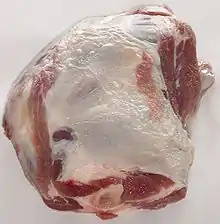
- Sheep, originating from western Asia, were domesticated with the help of dogs prior to the establishment of settled agriculture, likely as early as the 8th millennium BCE.[1]: 3 Several breeds of sheep were established in ancient Mesopotamia and Egypt by 3500–3000 BCE.[1]: 3 Today, more than 200 sheep-breeds exist.
- Cattle were domesticated in Mesopotamia after settled agriculture was established about 5000 BCE,[1]: 5 and several breeds were established by 2500 BCE.[1]: 6 Modern domesticated cattle fall into the groups Bos taurus (European cattle) and Bos taurus indicus (zebu), both descended from the now-extinct aurochs.[1]: 5 The breeding of beef cattle, cattle optimized for meat production as opposed to animals best suited for work or dairy purposes, began in the middle of the 18th century.[1]: 7
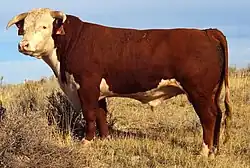
- Domestic pigs, which are descended from wild boars, are known to have existed about 2500 BCE in modern-day Hungary and in Troy; earlier pottery from Tell es-Sultan (Jericho) and Egypt depicts wild pigs.[1]: 8 Pork sausages and hams were of great commercial importance in Greco-Roman times.[1]: 8 Pigs continue to be bred intensively as they are being optimized to produce meat best suited for specific meat products.[1]: 9
- Goats are among the earliest animals domesticated by humans.[5] The most recent genetic analysis[6] confirms the archaeological evidence that the wild bezoar ibex of the Zagros Mountains is the likely original ancestor of probably all domestic goats today.[5] Neolithic farmers began to herd wild goats primarily for easy access to milk and meat, as well as to their dung, which was used as fuel; and their bones, hair, and sinew were used for clothing, building, and tools.[7] The earliest remnants of domesticated goats dating 10,000 years Before Present are found in Ganj Dareh in Iran.[8] Goat remains have been found at archaeological sites in Jericho, Choga Mami,[9] Djeitun, and Çayönü, dating the domestication of goats in Western Asia at between 8,000 and 9,000 years ago.[5] Studies of DNA evidence suggests 10,000 years ago as the domestication date.[6]
- Chicken were domesticated around 6000 BCE in Southeast Asia, according to genomic analysis,[10] and spread to China and India 2000–3000 years later. Archaeological evidence supports domestic chickens in Southeast Asia well before 6000 BCE, China by 6000 BCE and India by 2000 BCE.[10][11][12]
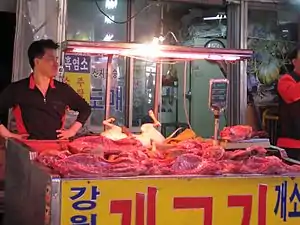
Other animals are or have been raised or hunted for their flesh. The type of meat consumed varies much between different cultures, changes over time, depending on factors such as tradition and the availability of the animals. The amount and kind of meat consumed also varies by income, both between countries and within a given country.[13]
- Deer are hunted for their meat (venison) in various regions.
- Horses are commonly eaten in France,[14] Italy, Germany and Japan, among other countries.[15] Horses and other large mammals such as reindeer were hunted during the late Paleolithic in western Europe.[16]
- Dogs are consumed in China,[17] South Korea[18] and Vietnam.[19] Dogs are also occasionally eaten in the Arctic regions.[20] Historically, dog meat has been consumed in various parts of the world, such as Hawaii,[21] Japan,[22] Switzerland[21] and Mexico.[23]
- Cats are consumed in Southern China, Peru[24] and sometimes also in Northern Italy.[25][26]
- Guinea pigs are raised for their flesh in the Andes.[27]
- Whales and dolphins are hunted, partly for their flesh, in Japan, Alaska, Siberia, Canada, the Faroe Islands, Greenland, Iceland, Saint Vincent and the Grenadines and by two small communities in Indonesia.[28]
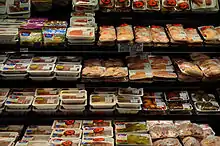
Modern agriculture employs a number of techniques, such as progeny testing, to speed artificial selection by breeding animals to rapidly acquire the qualities desired by meat producers.[1]: 10 For instance, in the wake of well-publicised health concerns associated with saturated fats in the 1980s, the fat content of United Kingdom beef, pork and lamb fell from 20–26 percent to 4–8 percent within a few decades, due to both selective breeding for leanness and changed methods of butchery.[1]: 10 Methods of genetic engineering aimed at improving the meat production qualities of animals are now also becoming available.[1]: 14
Even though it is a very old industry, meat production continues to be shaped strongly by the evolving demands of customers. The trend towards selling meat in pre-packaged cuts has increased the demand for larger breeds of cattle, which are better suited to producing such cuts.[1]: 11 Even more animals not previously exploited for their meat are now being farmed, especially the more agile and mobile species, whose muscles tend to be developed better than those of cattle, sheep or pigs.[1]: 11 Examples are the various antelope species, the zebra, water buffalo and camel,[1]: 11ff as well as non-mammals, such as the crocodile, emu and ostrich.[1]: 13 Another important trend in contemporary meat production is organic farming which, while providing no organoleptic benefit to meat so produced,[30] meets an increasing demand for organic meat.[31]
Consumption
| Animals | Number Killed |
|---|---|
| Chickens | 61,171,973,510 |
| Ducks | 2,887,594,480 |
| Pigs | 1,451,856,889 |
| Rabbits | 1,171,578,000 |
| Geese | 687,147,000 |
| Turkeys | 618,086,890 |
| Sheep | 536,742,256 |
| Goats | 438,320,370 |
| Cattle | 298,799,160 |
| Rodents | 70,371,000 |
| Pigeons and other birds | 59,656,000 |
| Buffalo | 25,798,819 |
| Horses | 4,863,367 |
| Donkeys and mules | 3,478,300 |
| Camels and other camelids | 3,298,266 |
Meat consumption varies worldwide, depending on cultural or religious preferences, as well as economic conditions. Vegetarians and vegans choose not to eat meat because of taste preferences, ethical, economic, environmental, religious, or health concerns that are associated with meat production and consumption.
According to the analysis of the FAO, the overall consumption for white meat between 1990 and 2009 has dramatically increased. Poultry meat has increased by 76.6% per kilo per capita and pig meat by 19.7%. Bovine meat has decreased from 10.4 kg (22 lb 15 oz) per capita in 1990 to 9.6 kg (21 lb 3 oz) per capita in 2009.[36]
Overall, diets that include meat are the most common worldwide according to the results of a 2018 Ipsos MORI study of 16–64 years olds in 28 countries. Ipsos states "An omnivorous diet is the most common diet globally, with non-meat diets (which can include fish) followed by over a tenth of the global population." Approximately 87% of people include meat in their diet in some frequency. 73% of meat eaters included it in their diet regularly and 14% consumed meat only occasionally or infrequently. Estimates of the non-meat diets were also broken down. About 3% of people followed vegan diets, where consumption of meat, eggs, and dairy are abstained from. About 5% of people followed vegetarian diets, where consumption of meat is abstained from, but egg and/or dairy consumption is not strictly restricted. About 3% of people followed pescetarian diets, where consumption of the meat of land animals is abstained from, fish meat and other seafood is consumed, and egg and/or dairy consumption may or may not be strictly restricted.[37]
History
A bioarchaeological (specifically, isotopic analysis) study of early medieval England found, based on the funerary record, that high-meat protein diets were extremely rare, and that (contrary to previously held assumptions) elites did not consume more meat than non-elites, and men did not consume more meat than women.[38]
In the nineteenth century meat consumption in Britain was the highest in Europe, exceeded only by that in British colonies. In the 1830s consumption per head in Britain was about 34 kilograms (75 lb) a year, rising to 59 kilograms (130 lb) in 1912. In 1904 laborers were found to consume 39 kilograms (87 lb) a year while aristocrats ate 140 kilograms (300 lb). There were estimated to be 43,000 meat purveyor establishments in Britain in 1910, with "possibly more money invested in the meat industry than in any other British business" except the finance industry.[39] The US was a meat importing country by 1926.[40]
Truncated lifespan as a result of intensive breeding allowed more meat to be produced from fewer animals. The world cattle population was about 600 million in 1929, with 700 million sheep and goats and 300 million pigs.[41] According to a study, the average lifespan of livestock pigs is ~2 years (7% of "maximum expected lifespan"). For dairy cattle the lifespan is ~5 years (27%).[42]
Animal growth and development
Agricultural science has identified several factors bearing on the growth and development of meat in animals.
Genetics
| Trait | Heritability[43] |
|---|---|
| Reproductive efficiency | 2–10% |
| Meat quality | 15–30% |
| Growth | 20–40% |
| Muscle/fat ratio | 40–60% |
Several economically important traits in meat animals are heritable to some degree (see the adjacent table) and can thus be selected for by animal breeding. In cattle, certain growth features are controlled by recessive genes which have not so far been controlled, complicating breeding.[1]: 18 One such trait is dwarfism; another is the doppelender or "double muscling" condition, which causes muscle hypertrophy and thereby increases the animal's commercial value.[1]: 18 Genetic analysis continues to reveal the genetic mechanisms that control numerous aspects of the endocrine system and, through it, meat growth and quality.[1]: 19
Genetic engineering techniques can shorten breeding programs significantly because they allow for the identification and isolation of genes coding for desired traits, and for the reincorporation of these genes into the animal genome.[1]: 21 To enable such manipulation, research is ongoing (as of 2006) to map the entire genome of sheep, cattle and pigs.[1]: 21 Some research has already seen commercial application. For instance, a recombinant bacterium has been developed which improves the digestion of grass in the rumen of cattle, and some specific features of muscle fibres have been genetically altered.[1]: 22
Experimental reproductive cloning of commercially important meat animals such as sheep, pig or cattle has been successful. Multiple asexual reproduction of animals bearing desirable traits is anticipated,[1]: 22 although this is not yet practical on a commercial scale.
Environment
Heat regulation in livestock is of great economic significance, because mammals attempt to maintain a constant optimal body temperature. Low temperatures tend to prolong animal development and high temperatures tend to retard it.[1]: 22 Depending on their size, body shape and insulation through tissue and fur, some animals have a relatively narrow zone of temperature tolerance and others (e.g. cattle) a broad one.[1]: 23 Static magnetic fields, for reasons still unknown, also retard animal development.[1]: 23
Nutrition
The quality and quantity of usable meat depends on the animal's plane of nutrition, i.e., whether it is over- or underfed. Scientists disagree about how exactly the plane of nutrition influences carcass composition.[1]: 25
The composition of the diet, especially the amount of protein provided, is also an important factor regulating animal growth.[1]: 26 Ruminants, which may digest cellulose, are better adapted to poor-quality diets, but their ruminal microorganisms degrade high-quality protein if supplied in excess.[1]: 27 Because producing high-quality protein animal feed is expensive (see also Environmental impact below), several techniques are employed or experimented with to ensure maximum utilization of protein. These include the treatment of feed with formalin to protect amino acids during their passage through the rumen, the recycling of manure by feeding it back to cattle mixed with feed concentrates, or the partial conversion of petroleum hydrocarbons to protein through microbial action.[1]: 30
In plant feed, environmental factors influence the availability of crucial nutrients or micronutrients, a lack or excess of which can cause a great many ailments.[1]: 29 In Australia, for instance, where the soil contains limited phosphate, cattle are being fed additional phosphate to increase the efficiency of beef production.[1]: 28 Also in Australia, cattle and sheep in certain areas were often found losing their appetite and dying in the midst of rich pasture; this was at length found to be a result of cobalt deficiency in the soil.[1]: 29 Plant toxins are also a risk to grazing animals; for instance, sodium fluoroacetate, found in some African and Australian plants, kills by disrupting the cellular metabolism.[1]: 29 Certain man-made pollutants such as methylmercury and some pesticide residues present a particular hazard due to their tendency to bioaccumulate in meat, potentially poisoning consumers.[1]: 30
Animal welfare



A major concern for the welfare of farmed animals is factory farming in which large numbers of animals are reared in confinement at high stocking densities. Issues include the limited opportunities for natural behaviors, for example, in battery cages, veal and gestation crates, instead producing abnormal behaviors such as tail-biting, cannibalism, and feather pecking, and routine invasive procedures such as beak trimming, castration, and ear notching.More extensive methods of farming, e.g. free range, can also raise welfare concerns such as the mulesing of sheep and predation of stock by wild animals. Biosecurity is also a risk with free range farming, as it allows for more contact between livestock and wild animal populations, which may carry zoonoses.[47]
Farmed animals are artificially selected for production parameters which sometimes impinge on the animals' welfare. For example, broiler chickens are bred to be very large to produce the greatest quantity of meat per animal. Broilers bred for fast growth have a high incidence of leg deformities because the large breast muscles cause distortions of the developing legs and pelvis, and the birds cannot support their increased body weight. As a consequence, they frequently become lame or suffer from broken legs. The increased body weight also puts a strain on their hearts and lungs, and ascites often develop. In the UK alone, up to 20 million broilers each year die from the stress of catching and transporting before reaching the slaughterhouse.[48]
Another concern about the welfare of farmed animals is the method of slaughter, especially ritual slaughter. While the killing of animals need not necessarily involve suffering, the general public considers that killing an animal reduces its welfare.[49] This leads to further concerns about premature slaughtering such as chick culling by the laying hen industry, in which males are slaughtered immediately after hatching because they are superfluous; this policy occurs in other farmed animal industries such as the production of goat and cattle milk, raising the same concerns.
A 2023 report by the Animal Welfare Institute found that animal welfare claims by companies selling meat and poultry products lack adequate substantiation in roughly 85% of analyzed cases.[50][51]Livestock animals have shown relatively high intelligence which may raise animal ethics rationale for safeguarding their well-being. Pigs in particular are considered by some to be the smartest known domesticated animal in the world[52] (e.g. more intelligent than pet dogs)[53] which not only experience pain[54] but also have notable depths, levels and/or variety/diversity of emotions (including boredom),[55][56][57][58] cognition, intelligence, and/or sentience.[59][60] Complications include that without or reduced meat production, many livestock animals may never live (see also: natalism),[61] and that their life (relative timespan of existence) is typically short – in the case of pigs ~7% of their "maximum expected lifespan".[42]
Human intervention
Meat producers may seek to improve the fertility of female animals through the administration of gonadotrophic or ovulation-inducing hormones.[1]: 31 In pig production, sow infertility is a common problem – possibly due to excessive fatness.[1]: 32 No methods currently exist to augment the fertility of male animals.[1]: 32 Artificial insemination is now routinely used to produce animals of the best possible genetic quality, and the efficiency of this method is improved through the administration of hormones that synchronize the ovulation cycles within groups of females.[1]: 33
Growth hormones, particularly anabolic agents such as steroids, are used in some countries to accelerate muscle growth in animals.[1]: 33 This practice has given rise to the beef hormone controversy, an international trade dispute. It may also decrease the tenderness of meat, although research on this is inconclusive,[1]: 35 and have other effects on the composition of the muscle flesh.[1]: 36ff Where castration is used to improve control over male animals, its side effects are also counteracted by the administration of hormones.[1]: 33 Myostatin-based muscle hypertrophy has also been used.[62]
Sedatives may be administered to animals to counteract stress factors and increase weight gain.[1]: 39 The feeding of antibiotics to certain animals has been shown to improve growth rates also.[1]: 39 This practice is particularly prevalent in the US, but has been banned in the EU, partly because it causes antimicrobial resistance in pathogenic microorganisms.[1]: 39
Biochemical composition
Numerous aspects of the biochemical composition of meat vary in complex ways depending on the species, breed, sex, age, plane of nutrition, training and exercise of the animal, as well as on the anatomical location of the musculature involved.[1]: 94–126 Even between animals of the same litter and sex there are considerable differences in such parameters as the percentage of intramuscular fat.[1]: 126
Main constituents
Adult mammalian muscle flesh consists of roughly 75 percent water, 19 percent protein, 2.5 percent intramuscular fat, 1.2 percent carbohydrates and 2.3 percent other soluble non-protein substances. These include nitrogenous compounds, such as amino acids, and inorganic substances such as minerals.[1]: 76
Muscle proteins are either soluble in water (sarcoplasmic proteins, about 11.5 percent of total muscle mass) or in concentrated salt solutions (myofibrillar proteins, about 5.5 percent of mass).[1]: 75 There are several hundred sarcoplasmic proteins.[1]: 77 Most of them – the glycolytic enzymes – are involved in the glycolytic pathway, i.e., the conversion of stored energy into muscle power.[1]: 78 The two most abundant myofibrillar proteins, myosin and actin,[1]: 79 are responsible for the muscle's overall structure. The remaining protein mass consists of connective tissue (collagen and elastin) as well as organelle tissue.[1]: 79
Fat in meat can be either adipose tissue, used by the animal to store energy and consisting of "true fats" (esters of glycerol with fatty acids),[1]: 82 or intramuscular fat, which contains considerable quantities of phospholipids and of unsaponifiable constituents such as cholesterol.[1]: 82
Red and white
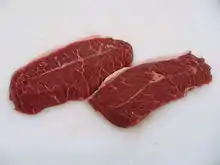
Meat can be broadly classified as "red" or "white" depending on the concentration of myoglobin in muscle fibre. When myoglobin is exposed to oxygen, reddish oxymyoglobin develops, making myoglobin-rich meat appear red. The redness of meat depends on species, animal age, and fibre type: Red meat contains more narrow muscle fibres that tend to operate over long periods without rest,[1]: 93 while white meat contains more broad fibres that tend to work in short fast bursts.[1]: 93
Generally, the meat of adult mammals such as cows, sheep, and horses is considered red, while chicken and turkey breast meat is considered white.[63]
Nutritional information
| Source | Energy: kJ (kcal) | Protein | Carbs | Fat |
|---|---|---|---|---|
| Fish | 460–590 (110–140) | 20–25 g | 0 g | 1–5 g |
| Chicken breast | 670 (160) | 28 g | 0 g | 7 g |
| Lamb | 1,000 (250) | 30 g | 0 g | 14 g |
| Steak (beef top round) | 880 (210) | 36 g | 0 g | 7 g |
| Steak (beef T-bone) | 1,900 (450) | 25 g | 0 g | 35 g |
| Dog (various cuts)[64] | 1,100 (270) | 20 g | 0 g | 22 g |
| Horse (strip steak)[65] | 590 (140) | 25 g | 0 g | 7 g |
| Pork loin[66] | 1,010 (242) | 14 g | 0 g | 30 g |
| Rabbit (domesticated)[67] | 900 (215) | 32 g | 0 g | 9 g |
All muscle tissue is very high in protein, containing all of the essential amino acids, and in most cases is a good source of zinc, vitamin B12, selenium, phosphorus, niacin, vitamin B6, choline, riboflavin and iron.[68] Several forms of meat are also high in vitamin K.[69] Muscle tissue is very low in carbohydrates and does not contain dietary fiber.[70] While taste quality may vary between meats, the proteins, vitamins, and minerals available from meats are generally consistent.
The fat content of meat can vary widely depending on the species and breed of animal, the way in which the animal was raised, including what it was fed, the anatomical part of the body, and the methods of butchering and cooking. Wild animals such as deer are typically leaner than farm animals, leading those concerned about fat content to choose game such as venison. Decades of breeding meat animals for fatness is being reversed by consumer demand for meat with less fat. The fatty deposits that exist with the muscle fibers in meats soften meat when it is cooked and improve the flavor through chemical changes initiated through heat that allow the protein and fat molecules to interact. The fat, when cooked with meat, also makes the meat seem juicier. The nutritional contribution of the fat is mainly calories as opposed to protein. As fat content rises, the meat's contribution to nutrition declines. In addition, there is cholesterol associated with fat surrounding the meat. The cholesterol is a lipid associated with the kind of saturated fat found in meat. The increase in meat consumption after 1960 is associated with, though not definitively the cause of, significant imbalances of fat and cholesterol in the human diet.[71]
The table in this section compares the nutritional content of several types of meat. While each kind of meat has about the same content of protein and carbohydrates, there is a very wide range of fat content.
Production

.svg.png.webp)
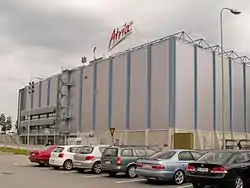
Meat is produced by killing an animal and cutting flesh out of it. These procedures are called slaughter and butchery, respectively. There is ongoing research into producing meat in vitro; that is, outside of animals.
Transport
Upon reaching a predetermined age or weight, livestock are usually transported en masse to the slaughterhouse. Depending on its length and circumstances, this may exert stress and injuries on the animals, and some may die en route.[1]: 129 Unnecessary stress in transport may adversely affect the quality of the meat.[1]: 129 In particular, the muscles of stressed animals are low in water and glycogen, and their pH fails to attain acidic values, all of which results in poor meat quality.[1]: 130 Consequently, and also due to campaigning by animal welfare groups, laws and industry practices in several countries tend to become more restrictive with respect to the duration and other circumstances of livestock transports.
Slaughter
Animals are usually slaughtered by being first stunned and then exsanguinated (bled out). Death results from the one or the other procedure, depending on the methods employed. Stunning can be effected through asphyxiating the animals with carbon dioxide, shooting them with a gun or a captive bolt pistol, or shocking them with electric current.[1]: 134ff In most forms of ritual slaughter, stunning is not allowed.
Draining as much blood as possible from the carcass is necessary because blood causes the meat to have an unappealing appearance and is a breeding ground for microorganisms.[1]: 1340 The exsanguination is accomplished by severing the carotid artery and the jugular vein in cattle and sheep, and the anterior vena cava in pigs.[1]: 137
The act of slaughtering animals for meat, or of raising or transporting animals for slaughter, may engender both psychological stress[73] and physical trauma[74] in the people involved. Additionally, slaughterhouse workers are exposed to noise of between 76 and 100 dB from the screams of animals being killed. 80 dB is the threshold at which the wearing of ear protection is recommended.[75]
Dressing and cutting
After exsanguination, the carcass is dressed; that is, the head, feet, hide (except hogs and some veal), excess fat, viscera and offal are removed, leaving only bones and edible muscle.[1]: 138 Cattle and pig carcases, but not those of sheep, are then split in half along the mid ventral axis, and the carcase is cut into wholesale pieces.[1]: 138 The dressing and cutting sequence, long a province of manual labor, is progressively being fully automated.[1]: 138
Conditioning
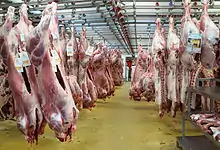
Under hygienic conditions and without other treatment, meat can be stored at above its freezing point (−1.5 °C) for about six weeks without spoilage, during which time it undergoes an aging process that increases its tenderness and flavor.[1]: 141
During the first day after death, glycolysis continues until the accumulation of lactic acid causes the pH to reach about 5.5. The remaining glycogen, about 18 g per kg, is believed to increase the water-holding capacity and tenderness of the flesh when cooked.[1]: 87 Rigor mortis sets in a few hours after death as ATP is used up, causing actin and myosin to combine into rigid actomyosin and lowering the meat's water-holding capacity,[1]: 90 causing it to lose water ("weep").[1]: 146 In muscles that enter rigor in a contracted position, actin and myosin filaments overlap and cross-bond, resulting in meat that is tough on cooking[1]: 144 – hence again the need to prevent pre-slaughter stress in the animal.
Over time, the muscle proteins denature in varying degree, with the exception of the collagen and elastin of connective tissue,[1]: 142 and rigor mortis resolves. Because of these changes, the meat is tender and pliable when cooked just after death or after the resolution of rigor, but tough when cooked during rigor.[1]: 142 As the muscle pigment myoglobin denatures, its iron oxidates, which may cause a brown discoloration near the surface of the meat.[1]: 146 Ongoing proteolysis also contributes to conditioning. Hypoxanthine, a breakdown product of ATP, contributes to the meat's flavor and odor, as do other products of the decomposition of muscle fat and protein.[1]: 155
Additives

When meat is industrially processed in preparation of consumption, it may be enriched with additives to protect or modify its flavor or color, to improve its tenderness, juiciness or cohesiveness, or to aid with its preservation. Meat additives include the following:[77]
- Salt is the most frequently used additive in meat processing. It imparts flavor but also inhibits microbial growth, extends the product's shelf life and helps emulsifying finely processed products, such as sausages. Ready-to-eat meat products normally contain about 1.5 to 2.5 percent salt.[77] Salt water or similar substances may also be injected into poultry meat to improve the taste and increase the weight, in a process called plumping.
- Nitrite is used in curing meat to stabilize the meat's color and flavor, and inhibits the growth of spore-forming microorganisms such as C. botulinum. The use of nitrite's precursor nitrate is now limited to a few products such as dry sausage, prosciutto or parma ham.[77]
- Phosphates used in meat processing are normally alkaline polyphosphates such as sodium tripolyphosphate. They are used to increase the water-binding and emulsifying ability of meat proteins, but also limit lipid oxidation and flavor loss, and reduce microbial growth.[77]
- Erythorbate or its equivalent ascorbic acid (vitamin C) is used to stabilize the color of cured meat.[77]
- Sweeteners such as sugar or corn syrup impart a sweet flavor, bind water and assist surface browning during cooking in the Maillard reaction.[77]
- Seasonings impart or modify flavor. They include spices or oleoresins extracted from them, herbs, vegetables and essential oils.[77]
- Flavorings such as monosodium glutamate impart or strengthen a particular flavor.[77]
- Tenderizers break down collagens to make the meat more palatable for consumption. They include proteolytic enzymes, acids, salt and phosphate.[77]
- Dedicated antimicrobials include lactic, citric and acetic acid, sodium diacetate, acidified sodium chloride or calcium sulfate, cetylpyridinium chloride, activated lactoferrin, sodium or potassium lactate, or bacteriocins such as nisin.[77]
- Antioxidants include a wide range of chemicals that limit lipid oxidation, which creates an undesirable "off flavor", in precooked meat products.[77]
- Acidifiers, most often lactic or citric acid, can impart a tangy or tart flavor note, extend shelf-life, tenderize fresh meat or help with protein denaturation and moisture release in dried meat. They substitute for the process of natural fermentation that acidifies some meat products such as hard salami or prosciutto.[77]
Misidentification
With the rise of complex supply chains, including cold chains, in developed economies, the distance between the farmer or fisherman and customer has grown, increasing the possibility for intentional and unintentional misidentification of meat at various points in the supply chain.[78]
In 2013, reports emerged across Europe that products labelled as containing beef actually contained horse meat.[79] In February 2013 a study was published showing that about one-third of raw fish are misidentified across the United States.[78]
Imitation
Various forms of imitation meat have been created for people who wish not to eat meat but still want to taste its flavor and texture. Meat imitates are typically some form of processed soybean (tofu, tempeh), but they can also be based on wheat gluten, pea protein isolate, or even fungi (quorn).
Environmental impact
Various environmental effects are associated with meat production. Among these are greenhouse gas emissions, fossil energy use, water use, water quality changes, and effects on grazed ecosystems.
The livestock sector may be the largest source of water pollution (due to animal wastes, fertilizers, pesticides), and it contributes to emergence of antibiotic resistance. It accounts for over 8% of global human water use. It is a significant driver of biodiversity loss and ecosystems, as it causes deforestation and requires large amounts of land for pasture and feed crops, ocean dead zones, land degradation, pollution, overfishing and climate change.[80][81][82][83][84][85][86]
The occurrence, nature and significance of environmental effects varies among livestock production systems.[87] Grazing of livestock can be beneficial for some wildlife species, but not for others.[88][89] Targeted grazing of livestock is used as a food-producing alternative to herbicide use in some vegetation management.[90]
Land use
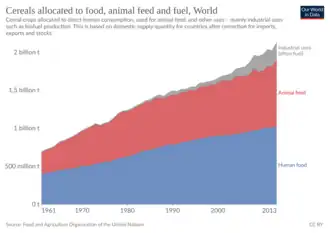
Meat production is by far the biggest cause of land use, as it accounts for nearly 40% of the global land surface.[95] Just in the contiguous United States, 34% of its land area (265 million hectares or 654 million acres) are used as pasture and rangeland, mostly feeding livestock, not counting 158 million hectares (391 million acres) of cropland (20%), some of which is used for producing feed for livestock.[96] Roughly 75% of deforested land around the globe is used for livestock pasture.[97] Deforestation from practices like slash-and-burn releases CO2 and removes the carbon sink of grown tropical forest ecosystems which substantially mitigate climate change.[98] The land use is a major pressure on pressure on fertile soils which is important for global food security.[99]
Climate change

The rising global consumption of carbon-intensive meat products has "exploded the global carbon footprint of agriculture," according to some top scientists.[100][101] Meat production is responsible for 14.5% and possibly up to 51% of the world's anthropogenic greenhouse gas emissions.[102][103] Some nations show very different impacts to counterparts within the same group, with Brazil and Australia having emissions over 200% higher than the average of their respective income groups and driven by meat consumption.[104]
According to the Assessing the Environmental Impacts of Consumption and Production report produced by United Nations Environment Programme's (UNEP) international panel for sustainable resource management, a worldwide transition in the direction of a meat and dairy free diet is indispensable if adverse global climate change were to be prevented.[105] A 2019 report in The Lancet recommended that global meat (and sugar) consumption be reduced by 50 percent to mitigate climate change.[106] Meat consumption in Western societies needs to be reduced by up to 90% according to a 2018 study published in Nature.[107][108] The 2019 special report by the Intergovernmental Panel on Climate Change called for significantly reducing meat consumption, particularly in wealthy countries, in order to mitigate and adapt to climate change.[109]
Biodiversity loss
Meat consumption is considered one of the primary contributors of the sixth mass extinction.[83][110][111][112] A 2017 study by the World Wildlife Fund found that 60% of global biodiversity loss is attributable to meat-based diets, in particular from the vast scale of feed crop cultivation needed to rear tens of billions of farm animals for human consumption puts an enormous strain on natural resources resulting in a wide-scale loss of lands and species.[113] Currently, livestock make up 60% of the biomass of all mammals on earth, followed by humans (36%) and wild mammals (4%).[114][115] In November 2017, 15,364 world scientists signed a Warning to Humanity calling for, among other things, drastically diminishing our per capita consumption of meat and "dietary shifts towards mostly plant-based foods".[116] The 2019 Global Assessment Report on Biodiversity and Ecosystem Services, released by IPBES, also recommended reductions in meat consumption in order to mitigate biodiversity loss.[117] A 2021 Chatham House report asserted that a significant shift towards plant-based diets would free up the land to allow for the restoration of ecosystems and thriving biodiversity.[118]
A July 2018 study in Science says that meat consumption is set to rise as the human population increases along with affluence, which will increase greenhouse gas emissions and further reduce biodiversity.[119][120]
Reducing environmental impact
The environmental impact of meat production can be reduced by conversion of human-inedible residues of food crops.[121][122] Manure from meat-producing livestock is used as fertilizer; it may be composted before application to food crops. Substitution of animal manures for synthetic fertilizers in crop production can be environmentally significant, as between 43 and 88 MJ of fossil fuel energy are used per kg of nitrogen in manufacture of synthetic nitrogenous fertilizers.[123]
Reducing meat consumption
The IPCC and many others, including scientific reviews of the literature and data on the topic, have concluded that meat production has to be reduced substantially for any sufficient mitigation of climate change and, at least initially, largely through shifts towards plant-based diets in cases (e.g. countries) where meat consumption is high.[109][124][108][125][126][127][35] A review names broad potential measures such as "restrictions or fiscal mechanisms".[128][35] Personal Carbon Allowances that allow a certain amount of free meat consumption per person would be a form of restriction, meat taxes would be a type of fiscal mechanism. Meat can be replaced by, for example, high-protein iron-rich low-emission legumes and common fungi, but there are also dietary supplements (e.g. of vitamin B12 and zinc) and/or fortified foods,[129][130][131][132] cultured meat, microbial foods,[133] mycoprotein,[134] meat substitutes, and other alternatives.[135][136][137][138][139][140] Farms can be transitioned to meet new demands, workers can enter relevant job retraining programs,[141] and land previously used for meat production can be rewilded.[126][86]
The biologists Rodolfo Dirzo, Gerardo Ceballos, and Paul R. Ehrlich emphasize that it is the "massive planetary monopoly of industrial meat production that needs to be curbed" while respecting the cultural traditions of indigenous peoples, for whom meat is an important source of protein.[142]
Spoilage and preservation
The spoilage of meat occurs, if untreated, in a matter of hours or days and results in the meat becoming unappetizing, poisonous or infectious. Spoilage is caused by the practically unavoidable infection and subsequent decomposition of meat by bacteria and fungi, which are borne by the animal itself, by the people handling the meat, and by their implements. Meat can be kept edible for a much longer time – though not indefinitely – if proper hygiene is observed during production and processing, and if appropriate food safety, food preservation and food storage procedures are applied. Without the application of preservatives and stabilizers, the fats in meat may also begin to rapidly decompose after cooking or processing, leading to an objectionable taste known as warmed over flavor.
Methods of preparation
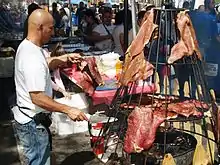
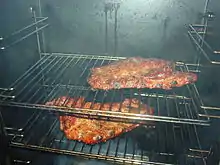

Fresh meat can be cooked for immediate consumption, or be processed, that is, treated for longer-term preservation and later consumption, possibly after further preparation. Fresh meat cuts or processed cuts may produce iridescence, commonly thought to be due to spoilage but actually caused by structural coloration and diffraction of the light.[143] A common additive to processed meats for both preservation and the prevention of discoloration is sodium nitrite. This substance is a source of health concerns because it may form carcinogenic nitrosamines when heated.[144]
Meat is prepared in many ways, as steaks, in stews, fondue, or as dried meat like beef jerky. It may be ground then formed into patties (as hamburgers or croquettes), loaves, or sausages, or used in loose form (as in "sloppy joe" or Bolognese sauce).
Some meat is cured by smoking, which is the process of flavoring, cooking, or preserving food by exposing it to the smoke from burning or smoldering plant materials, most often wood. In Europe, alder is the traditional smoking wood, but oak is more often used now, and beech to a lesser extent. In North America, hickory, mesquite, oak, pecan, alder, maple, and fruit-tree woods are commonly used for smoking. Meat can also be cured by pickling, preserving in salt or brine (see salted meat and other curing methods). Other kinds of meat are marinated and barbecued, or simply boiled, roasted, or fried.
Meat is generally eaten cooked, but many recipes call for raw beef, veal or fish (tartare). Steak tartare is a meat dish made from finely chopped or minced raw beef or horse meat.[145][146] Meat is often spiced or seasoned, particularly with meat products such as sausages. Meat dishes are usually described by their source (animal and part of body) and method of preparation (e.g., a beef rib).
Meat is a typical base for making sandwiches. Popular varieties of sandwich meat include ham, pork, salami and other sausages, and beef, such as steak, roast beef, corned beef, pepperoni, and pastrami. Meat can also be molded or pressed (common for products that include offal, such as haggis and scrapple) and canned.
Health
There is concern and debate regarding the potential association of meat, in particular red and processed meat, with a variety of health risks.
The 2015–2020 Dietary Guidelines for Americans asked men and teenage boys to increase their consumption of vegetables or other underconsumed foods (fruits, whole grains, and dairy) while reducing intake of protein foods (meats, poultry, and eggs) that they currently overconsume.[147]
Contamination
Various toxic compounds can contaminate meat, including heavy metals, mycotoxins, pesticide residues, dioxins, polychlorinated biphenyl (PCBs). Processed, smoked and cooked meat may contain carcinogens such as polycyclic aromatic hydrocarbons.[148]
Toxins may be introduced to meat as part of animal feed, as veterinary drug residues, or during processing and cooking. Often, these compounds can be metabolized in the body to form harmful by-products. Negative effects depend on the individual genome, diet, and history of the consumer.[149] Any chemical's toxicity is also dependent on the dose and timing of exposure.
Cancer
There are concerns about a relationship between the consumption of meat, in particular processed and red meat, and increased cancer risk. The International Agency for Research on Cancer (IARC), a specialized agency of the World Health Organization (WHO), classified processed meat (e.g., bacon, ham, hot dogs, sausages) as, "carcinogenic to humans (Group 1), based on sufficient evidence in humans that the consumption of processed meat causes colorectal cancer."[150][151] IARC also classified red meat as "probably carcinogenic to humans (Group 2A), based on limited evidence that the consumption of red meat causes cancer in humans and strong mechanistic evidence supporting a carcinogenic effect."[152][153][154]
Cancer Research UK, National Health Service (NHS) and the National Cancer Institute have stated that red and processed meat intake increases risk of bowel cancer.[155][156][157] The American Cancer Society in their "Diet and Physical Activity Guideline", stated "evidence that red and processed meats increase cancer risk has existed for decades, and many health organizations recommend limiting or avoiding these foods."[158] The Canadian Cancer Society have stated that "eating red and processed meat increases cancer risk".[159]
A 2021 review found an increase of 11–51% risk of multiple cancer per 100g/d increment of red meat, and an increase of 8–72% risk of multiple cancer per 50g/d increment of processed meat.[160]
Bacterial contamination
Bacterial contamination has been seen with meat products. A 2011 study by the Translational Genomics Research Institute showed that nearly half (47%) of the meat and poultry in U.S. grocery stores were contaminated with S. aureus, with more than half (52%) of those bacteria resistant to antibiotics.[161] A 2018 investigation by the Bureau of Investigative Journalism and The Guardian found that around 15 percent of the US population suffers from foodborne illnesses every year. The investigation also highlighted unsanitary conditions in US-based meat plants, which included meat products covered in excrement and abscesses "filled with pus".[162]
Diabetes
A 2022 review found that consumption of 100 g/day of red meat and 50 g/day of processed meat were associated with an increased risk of diabetes.[163]
Diabetes UK advises people to limit their intake of red and processed meat.[164][165]
Infectious diseases
Meat production and trade substantially increases risks for infectious diseases, including of pandemics – "directly through increased contact with wild and farmed animals [(zoonosis)] or indirectly through its impact on the environment (e.g., biodiversity loss, water use, climate change)".[127][166][167] For example, avian influenza from poultry meat production can be a threat to human health.[168][169][170][171][172][173] Furthermore, the use of antibiotics in meat production contributes to antimicrobial resistance – which contributes to millions of deaths[174] – and makes it harder to control infectious diseases.[175][176][177][178][179][180][181][182]
Changes in consumer behavior
In response to changing meat prices as well as health concerns about saturated fat and cholesterol (see lipid hypothesis), consumers have altered their consumption of various meats. A USDA report points out that consumption of beef in the United States between 1970 and 1974 and 1990–1994 dropped by 21%, while consumption of chicken increased by 90%.[183] During the same period of time, the price of chicken dropped by 14% relative to the price of beef. From 1995 to 1996, beef consumption increased due to higher supplies and lower prices.
Cooking
Meat can transmit certain diseases, but complete cooking and avoiding recontamination reduces this possibility.[184]
Several studies published since 1990 indicate that cooking muscle meat creates heterocyclic amines (HCAs), which are thought to increase cancer risk in humans. Researchers at the National Cancer Institute published results of a study which found that human subjects who ate beef rare or medium-rare had less than one third the risk of stomach cancer than those who ate beef medium-well or well-done.[185] While eating muscle meat raw may be the only way to avoid HCAs fully, the National Cancer Institute states that cooking meat below 100 °C (212 °F) creates "negligible amounts" of HCAs. Also, microwaving meat before cooking may reduce HCAs by 90%.[186]
Nitrosamines, present in processed and cooked foods, have been noted as being carcinogenic, being linked to colon cancer. Also, toxic compounds called PAHs, or polycyclic aromatic hydrocarbons, present in processed, smoked and cooked foods, are known to be carcinogenic.[148]
Heart disease
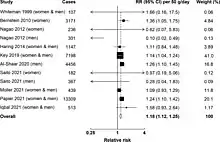
A 2012 review found that processed red meat increases risk of coronary heart disease, whilst unprocessed red meat has a smaller increase or no risk. The review concluded that that neither unprocessed red nor processed meat consumption is beneficial for cardiometabolic health.[188]
A 2021 review concluded that, except for poultry, at 50 g/day unprocessed red and processed meat appear to be risk factors for ischemic heart disease, increasing the risk by about 9 and 18% respectively.[187][189]
A 2022 review found that high consumption of red meat was associated with a 15 % increased risk of cardiovascular disease.[190]
Sociology
Meat is part of the human diet in most cultures, where it often has symbolic meaning and important social functions.[191] Some people choose not to eat meat (vegetarianism) or any food made from animals (veganism). The reasons for not eating all or some meat may include ethical objections to killing animals for food, health concerns, environmental concerns or religious dietary laws.
Ethics
Ethical issues regarding the consumption of meat include objecting to the act of killing animals or to the agricultural practices used in meat production. Reasons for objecting to killing animals for consumption may include animal rights, environmental ethics, or an aversion to inflicting pain or harm on other sentient creatures. Some people, while not vegetarians, refuse to eat the flesh of certain animals (such as cows, pigs, cats, dogs, horses, or rabbits) due to cultural or religious traditions.
Philosophy
The founders of Western philosophy disagreed about the ethics of eating meat. Plato's Republic has Socrates describe the ideal state as vegetarian.[192][192]: 10 Pythagoras believed that humans and animals were equal and therefore disapproved of meat consumption, as did Plutarch, whereas Zeno and Epicurus were vegetarian but allowed meat-eating in their philosophy.[192]: 10 Conversely, Aristotle's Politics assert that animals, as inferior beings,[193] exist to serve humans, including as food.[192]: 10 [194] Augustine drew on Aristotle to argue that the universe's natural hierarchy allows humans to eat animals, and animals to eat plants.[192]: 10 Enlightenment philosophers were likewise divided. Descartes wrote that animals are merely animated machines, and Kant considered them inferior beings for lack of discernment; means rather than ends.[192]: 11 But Voltaire and Rousseau disagreed.[192]: 11 The latter argued that meat-eating is a social rather than a natural act, because children are not interested in meat.[192]: 11
Later philosophers examined the changing practices of eating meat in the modern age as part of a process of detachment from animals as living beings. Norbert Elias, for instance, noted that in medieval times cooked animals were brought to the table whole, but that since the Renaissance only the edible parts are served, which are no longer recognizably part of an animal.[192]: 12 Modern eaters, according to Noëlie Vialles, demand an "ellipsis" between meat and dead animals; for instance, calves' eyes are no longer considered a delicacy as in the Middle Ages, but provoke disgust.[192]: 12 Even in the English language, distinctions emerged between animals and their meat, such as between cattle and beef, pigs and pork.[192]: 12 Fernand Braudel wrote that since the European diet of the 15th and 16th century was particularly heavy in meat, European colonialism helped export meat-eating across the globe, as colonized peoples took up the culinary habits of their colonizers, which they associated with wealth and power.[192]: 15

Religious traditions
The religion of Jainism has always opposed eating meat, and there are also schools of Buddhism and Hinduism that condemn the eating of meat.
Jewish dietary rules (Kashrut) allow certain (kosher) meat and forbid other (treif). The rules include prohibitions on the consumption of unclean animals (such as pork, shellfish including mollusca and crustacea, and most insects), and mixtures of meat and milk.
Similar rules apply in Islamic dietary laws: The Quran explicitly forbids meat from animals that die naturally, blood, the meat of swine (porcine animals, pigs), and animals dedicated to other than Allah (either undedicated or dedicated to idols) which are haram as opposed to halal.
Sikhism forbids meat of slowly slaughtered animals ("kutha") and prescribes killing animals with a single strike ("jhatka"), but some Sikh groups oppose eating any meat.[195]
Psychology
Research in applied psychology has investigated practices of meat eating in relation to morality, emotions, cognition, and personality characteristics.[196] Psychological research suggests meat eating is correlated with masculinity,[197] support for social hierarchy,[198] and reduced openness to experience.[199] Research into the consumer psychology of meat is relevant both to meat industry marketing[200] and to advocates of reduced meat consumption.[201][202]
Gender
Unlike most other food, meat is not perceived as gender-neutral, and is particularly associated with men and masculinity. Sociological research, ranging from African tribal societies to contemporary barbecues, indicates that men are much more likely to participate in preparing meat than other food.[192]: 15 This has been attributed to the influence of traditional male gender roles, in view of a "male familiarity with killing" (Goody) or roasting being more violent as opposed to boiling (Lévi-Strauss).[192]: 15 By and large, at least in modern societies, men also tend to consume more meat than women, and men often prefer red meat whereas women tend to prefer chicken and fish.[192]: 16
See also
References
- Lawrie, R.A.; Ledward, D A. (2006). Lawrie's meat science (7th ed.). Cambridge: Woodhead Publishing Limited. ISBN 978-1-84569-159-2.
- "Meat definition and meaning | Collins English Dictionary". www.collinsdictionary.com. Archived from the original on July 12, 2017. Retrieved June 16, 2017.
- "Definition of MEAT". merriam-webster.com. Archived from the original on March 19, 2018. Retrieved June 16, 2017.
- "Pig or Pork? Cow or Beef?". Voice of America. November 11, 2017. Retrieved August 4, 2020.
- "Breeds of Livestock; Goats: (Capra hircus)". Oklahoma State University Board of Regents. January 19, 2021.
- Naderi, Saeid; Rezaei, Hamid-Reza; Pompanon, François; Blum, Michael G. B.; Negrini, Riccardo; Naghash, Hamid-Reza; Balkiz, Özge; Mashkour, Marjan; Gaggiotti, Oscar E.; Ajmone-Marsan, Paolo; Kence, Aykut; Vigne, Jean-Denis; Taberlet, Pierre (November 18, 2008). "The goat domestication process inferred from large-scale mitochondrial DNA analysis of wild and domestic individuals". PNAS. 105 (46): 17659–17664. Bibcode:2008PNAS..10517659N. doi:10.1073/pnas.0804782105. PMC 2584717. PMID 19004765.
- "Why Would Anyone Try to Domesticate a Goat?". ThoughtCo. Retrieved December 30, 2022.
- Trinity College Dublin (June 7, 2021). "10,000-year-old DNA pens the first tales of the earliest domesticated goats". Phys.org.
- Maisels, Charles Keith (1998). Near East: Archaeology in the 'Cradle of Civilization'. Routledge. ISBN 978-0-415-18607-0.
- Lawal, Raman Akinyanju; Martin, Simon H.; Vanmechelen, Koen; Vereijken, Addie; Silva, Pradeepa; Al-Atiyat, Raed Mahmoud; Aljumaah, Riyadh Salah; Mwacharo, Joram M.; Wu, Dong-Dong; Zhang, Ya-Ping; Hocking, Paul M.; Smith, Jacqueline; Wragg, David; Hanotte, Olivier (December 2020). "The wild species genome ancestry of domestic chickens". BMC Biology. 18 (1): 13. doi:10.1186/s12915-020-0738-1. PMC 7014787. PMID 32050971.
- West, B.; Zhou, B.X. (1988). "Did chickens go north? New evidence for domestication". J. Archaeol. Sci. 14 (5): 515–533. Bibcode:1988JArSc..15..515W. doi:10.1016/0305-4403(88)90080-5.
- Al-Nasser, A.; Al-Khalaifa, H.; Al-Saffar, A.; Khalil, F.; Albahouh, M.; Ragheb, G.; Al-Haddad, A.; Mashaly, M. (June 1, 2007). "Overview of chicken taxonomy and domestication". World's Poultry Science Journal. 63 (2): 285–300. doi:10.1017/S004393390700147X. S2CID 86734013.
- Mark Gehlhar and William Coyle, "Global Food Consumption and Impacts on Trade Patterns" Archived September 5, 2012, at the Wayback Machine, Chapter 1 in Changing Structure of Global Food Consumption and Trade Archived February 26, 2013, at the Wayback Machine, edited by Anita Regmi, May 2001. USDA Economic Research Service.
- "France's horsemeat lovers fear US ban". The Guardian. June 14, 2007. Retrieved December 30, 2022.
- Alan Davidson (2006). Tom Jaine, Jane Davidson and Helen Saberi. ed. The Oxford Companion to Food. Oxford: Oxford University Press. ISBN 0-19-280681-5, pp. 387–88
- Turner, E. 2005. "Results of a recent analysis of horse remains dating to the Magdalenian period at Solutre, France," pp. 70–89. In Mashkour, M (ed.). Equids in Time and Space. Oxford: Oxbow
- "Programmes – From Our Own Correspondent – China's taste for the exotic". BBC. June 29, 2002. Archived from the original on February 1, 2011. Retrieved February 4, 2011.
- Podberscek, A.L. (2009). "Good to Pet and Eat: The Keeping and Consuming of Dogs and Cats in South Korea" (PDF). Journal of Social Issues. 65 (3): 615–632. CiteSeerX 10.1.1.596.7570. doi:10.1111/j.1540-4560.2009.01616.x. Archived from the original (PDF) on July 19, 2011.
- "Asia-Pacific – Vietnam's dog meat tradition". BBC. December 31, 2001. Archived from the original on July 22, 2011. Retrieved February 4, 2011.
- Francis H. Fay (June 1960) "Carnivorous walrus and some arctic zoonoses". Arctic 13, no.2: 111–22 Archived July 6, 2011, at the Wayback Machine
- Schwabe, Calvin W. (1979). Unmentionable Cuisine. University of Virginia Press. ISBN 978-0-8139-1162-5.
- Hanley, Susan B. (1997). Everyday Things in Premodern Japan: The Hidden Legacy of Material Culture. University of California Press. p. 66. ISBN 978-0-520-92267-9.
- Alan Davidson (2006). Tom Jaine, Jane Davidson and Helen Saberi. ed. The Oxford Companion to Food. Oxford: Oxford University Press. ISBN 0-19-280681-5, pp. 491
- "Carapulcra de gato y gato a la parrilla sirven en fiesta patronal". Cronica Viva. Archived from the original on November 17, 2010. Retrieved December 1, 2011.
- Hopkins, Jerry (May 15, 2004). Extreme Cuisine: The Weird and Wonderful Foods That People Eat. Tuttle Publishing. p. 25. ISBN 978-1-4629-0472-3.
- Hopkins, Jerry (1999). Strange Foods. Tuttle Publishing. p. 8. ISBN 978-1-4629-1676-4.
- "A Guinea Pig for All Times and Seasons". The Economist. July 15, 2004. Archived from the original on February 22, 2012. Retrieved December 1, 2011.
- "Whaling in Lamaera-Flores" (PDF). Archived (PDF) from the original on June 20, 2013. Retrieved April 10, 2013.
- "Humans just 0.01% of all life but have destroyed 83% of wild mammals – study". The Guardian. May 21, 2018. Retrieved December 30, 2022.
- Lawrie, 11, citing Ollson, V., Andersson, I., Ranson, K., Lundström, K. (2003) Meat Sci. 64, 287 and noting also that organically reared pigs "compare unfavourably" with conventionally reared ones "in some respects."
- "Demand for organic meat on the rise, says Soil Association". July 28, 2016. Archived from the original on October 12, 2016. Retrieved January 21, 2018.
- "FAOSTAT". fao.org. Archived from the original on May 11, 2017. Retrieved October 25, 2019.
- Meat Atlas 2014 – Facts and figures about the animals we eat, p. 46, download as pdf Archived July 8, 2018, at the Wayback Machine
- Meat Atlas 2014 – Facts and figures about the animals we eat, p. 48, download as pdf Archived July 8, 2018, at the Wayback Machine
- Parlasca, Martin C.; Qaim, Matin (October 5, 2022). "Meat Consumption and Sustainability". Annual Review of Resource Economics. 14: 17–41. doi:10.1146/annurev-resource-111820-032340. ISSN 1941-1340.
- Henchion, Maeve; McCarthy, Mary; Resconi, Virginia C.; Troy, Declan (November 2014). "Meat consumption: Trends and quality matters" (PDF). Meat Science. 98 (3): 561–568. doi:10.1016/j.meatsci.2014.06.007. hdl:11019/767. PMID 25060586. Archived (PDF) from the original on November 2, 2017. Retrieved September 24, 2019.
- "An exploration into diets around the world" (PDF). Ipsos. UK. August 2018. pp. 2, 10, 11. Archived (PDF) from the original on May 12, 2019.
- Leggett, Sam; Lambert, Tom (2022). "Food and Power in Early Medieval England: a Lack of (Isotopic) Enrichment". Anglo-Saxon England. 49: 155–196. doi:10.1017/S0263675122000072. ISSN 0263-6751. S2CID 257354036.
- Otter, Chris (2020). Diet for a large planet. USA: University of Chicago Press. p. 47. ISBN 978-0-226-69710-9.
- Otter, Chris (2020). Diet for a large planet. USA: University of Chicago Press. p. 28. ISBN 978-0-226-69710-9.
- Otter, Chris (2020). Diet for a large planet. USA: University of Chicago Press. p. 35. ISBN 978-0-226-69710-9.
- Hoffman, Jessica M.; Valencak, Teresa G. (June 1, 2020). "A short life on the farm: aging and longevity in agricultural, large-bodied mammals". GeroScience. 42 (3): 909–922. doi:10.1007/s11357-020-00190-4. ISSN 2509-2723. PMC 7286991. PMID 32361879.
- Table adapted from Lawrie, 17.
- "RSPCA says egg industry is 'misleading the public' on free range". Australian Broadcasting Corporation. September 24, 2014. Archived from the original on November 1, 2016. Retrieved May 26, 2015.
- "What The Rise Of Cage-Free Eggs Means For Chickens". NPR. Archived from the original on February 11, 2021. Retrieved May 26, 2015.
- Kelto, Anders (December 23, 2014). "Farm Fresh? Natural? Eggs Not Always What They're Cracked Up To Be". NPR. Archived from the original on November 3, 2020. Retrieved May 26, 2015.
- Bartlett, Harriet; Holmes, Mark A.; Petrovan, Silviu O.; Williams, David R.; Wood, James L. N.; Balmford, Andrew (June 2022). "Understanding the relative risks of zoonosis emergence under contrasting approaches to meeting livestock product demand". Royal Society Open Science. 9 (6): 211573. Bibcode:2022RSOS....911573B. doi:10.1098/rsos.211573. ISSN 2054-5703. PMC 9214290. PMID 35754996.
- "Compassion in World Farming – Meat chickens – Welfare issues". Compassion In World Farming. Archived from the original on October 23, 2013. Retrieved October 22, 2013.
- Phillips 2009. p 10.
- Axworthy, Nicole (April 10, 2023). "85 Percent of Meat Welfare Claims Lack Substantiation, New Research Finds". VegNews. Retrieved April 17, 2023.
- "Deceptive Consumer Labels" (PDF). Animal Welfare Institute. 2023. Retrieved April 17, 2023.
- "The Joy of Pigs ~ Pig Facts | Nature | PBS". Nature. November 10, 1996. Retrieved May 31, 2022.
- Samuel, Sigal (September 23, 2020). "Pigs are as smart as dogs. Why do we eat one and love the other?". Vox. Retrieved May 31, 2022.
- Samuel, Sigal (September 23, 2020). "Pigs are as smart as dogs. Why do we eat one and love the other?". Vox.
- Pietrosemoli, Silvana; Tang, Clara (June 2020). "Animal Welfare and Production Challenges Associated with Pasture Pig Systems: A Review". Agriculture. 10 (6): 223. doi:10.3390/agriculture10060223. ISSN 2077-0472.
- Zapata Cardona, Juliana; Ceballos, Maria Camila; Tarazona Morales, Ariel Marcel; David Jaramillo, Edimer; Rodríguez, Berardo de Jesús (March 1, 2022). "Music modulates emotional responses in growing pigs". Scientific Reports. 12 (1): 3382. Bibcode:2022NatSR..12.3382Z. doi:10.1038/s41598-022-07300-6. ISSN 2045-2322. PMC 8888585. PMID 35233051.
- Briefer, Elodie F.; Sypherd, Ciara C.-R.; Linhart, Pavel; Leliveld, Lisette M. C.; Padilla de la Torre, Monica; Read, Eva R.; Guérin, Carole; Deiss, Véronique; Monestier, Chloé; Rasmussen, Jeppe H.; Špinka, Marek; Düpjan, Sandra; Boissy, Alain; Janczak, Andrew M.; Hillmann, Edna; Tallet, Céline (March 7, 2022). "Classification of pig calls produced from birth to slaughter according to their emotional valence and context of production". Scientific Reports. 12 (1): 3409. Bibcode:2022NatSR..12.3409B. doi:10.1038/s41598-022-07174-8. ISSN 2045-2322. PMC 8901661. PMID 35256620.
- Johnson, A K; Rault, J-L; Marchant, J N; Baxter, E M; O’Driscoll, K (May 10, 2022). "Improving young pig welfare on-farm: The Five Domains Model". Journal of Animal Science. 100 (6): skac164. doi:10.1093/jas/skac164. PMC 9202571. PMID 35536191.
- Marino, Lori; Colvin, Christina M. (2015). "Thinking Pigs: A Comparative Review of Cognition, Emotion, and Personality in Sus domesticus". International Journal of Comparative Psychology. 28 (1). ISSN 0889-3675.
- Angier, Natalie (November 9, 2009). "Pigs Prove to Be Smart, if Not Vain". The New York Times. Retrieved May 31, 2022.
- Bramble, Ben; Fischer, Bob (October 1, 2015). The Moral Complexities of Eating Meat. Oxford University Press. ISBN 978-0-19-935392-7.
- Aiello, D.; Patel, K.; Lasagna, E. (December 2018). "The myostatin gene: an overview of mechanisms of action and its relevance to livestock animals" (PDF). Animal Genetics. 49 (6): 505–519. doi:10.1111/age.12696. PMID 30125951. S2CID 52051853.
- "White Meat vs. Red Meat / Nutrition / Healthy Eating". Archived from the original on May 5, 2017. Retrieved April 25, 2017.
- Ann Yong-Geun "Dog Meat Foods in Korea" Archived October 7, 2007, at Wikiwix, Table 4. Composition of dog meat and Bosintang (in 100g, raw meat), Korean Journal of Food and Nutrition 12(4) 397 – 408 (1999).
- "Nutrition Facts and Analysis for Beef, grass-fed, strip steaks, lean only, raw". Archived from the original on October 25, 2019. Retrieved February 8, 2013.
- "FoodData Central". fdc.nal.usda.gov. Archived from the original on December 3, 2019. Retrieved October 25, 2019.
- "FoodData Central". fdc.nal.usda.gov. Archived from the original on October 25, 2019. Retrieved October 26, 2019.
- "Don't Miss Out on the Benefits of Naturally Nutrient-Rich Lean Beef" (PDF). Archived from the original (PDF) on February 27, 2008. Retrieved January 11, 2008.
- Schurgers, L.J.; Vermeer, C. (2000). "Determination of phylloquinone and menaquinones in food. Effect of food matrix on circulating vitamin K concentrations". Haemostasis. 30 (6): 298–307. doi:10.1159/000054147. PMID 11356998. S2CID 84592720.
- "Dietary Fiber". Ext.colostate.edu. Archived from the original on June 28, 2013. Retrieved May 1, 2010.
- Horowitz, Roger. "Putting Meat on the American Table: Taste, Technology, Transformation" The Johns Hopkins University Press, 2005 p. 4.
- World Food and Agriculture – Statistical Yearbook 2021. Rome: FAO. 2021. doi:10.4060/cb4477en. ISBN 978-92-5-134332-6. S2CID 240163091.
- "Sheep farmer who felt so guilty about driving his lambs to slaughter rescues them and becomes a vegetarian". The Independent. January 30, 2019. Archived from the original on January 31, 2019. Retrieved January 30, 2019.Victor, Karen; Barnard, Antoni (April 20, 2016). "Slaughtering for a living: A hermeneutic phenomenological perspective on the well-being of slaughterhouse employees". International Journal of Qualitative Studies on Health and Well-being. 11: 30266. doi:10.3402/qhw.v11.30266. PMC 4841092. PMID 27104340."Working 'The Chain,' Slaughterhouse Workers Face Lifelong Injuries". Npr.org. Archived from the original on May 19, 2019. Retrieved January 30, 2019.Dorovskikh, Anna (2015). Killing for a Living: Psychological and Physiological Effects of Alienation of Food Production on Slaughterhouse Workers (Undergraduate honors thesis). University of Colorado Boulder. Retrieved April 16, 2023."PTSD in the Slaughterhouse". The Texas Observer. February 7, 2012. Archived from the original on January 30, 2019. Retrieved January 30, 2019.Newkey-Burden, Chas (November 19, 2018). "There's a Christmas crisis going on: no one wants to kill your dinner – Chas Newkey-Burden". The Guardian. Archived from the original on January 30, 2019. Retrieved January 30, 2019."Psychological Distress Among Slaughterhouse Workers Warrants Further Study – SPH – Boston University". School of Public Health. Archived from the original on January 30, 2019. Retrieved January 30, 2019.Dillard, Jennifer (Summer 2008). "A Slaughterhouse Nightmare: Psychological Harm Suffered by Slaughterhouse Employees and the Possibility of Redress through Legal Reform". Georgetown Journal on Poverty Law and Policy. 15 (2): 391–408. ISSN 1524-3974. Retrieved January 30, 2019.Sandhu, Serina (March 2, 2018). "'I couldn't look them in the eye': Farmer who couldn't slaughter his cows is turning his farm vegan". i (newspaper). Archived from the original on January 10, 2019. Retrieved January 30, 2019.Fox, Katrina. "Meet The Former Livestock Agent Who Started An International Vegan Food Business". Forbes. Archived from the original on January 31, 2019. Retrieved January 30, 2019.Lebwohl, Michael (January 25, 2016). "A Call to Action: Psychological Harm in Slaughterhouse Workers". The Yale Global Health Review. Archived from the original on May 25, 2019. Retrieved May 23, 2019.Nagesh, Ashitha (December 31, 2017). "The harrowing psychological toll of slaughterhouse work". Metro. Archived from the original on May 25, 2019. Retrieved May 23, 2019.
- "Two amputations a week: the cost of working in a US meat plant". The Guardian. July 5, 2018. Archived from the original on May 19, 2019. Retrieved May 23, 2019.Lowe, Peggy (August 11, 2016). "Working 'The Chain,' Slaughterhouse Workers Face Lifelong Injuries". NPR. Archived from the original on May 19, 2019. Retrieved May 23, 2019.Grabell, Michael (May 23, 2018). "Live on the Live". Oxfam America. Archived from the original on May 17, 2019. Retrieved May 23, 2019.Waldman, Peter (December 29, 2017). "America's Worst Graveyard Shift Is Grinding Up Workers". Bloomberg.com. Archived from the original on May 24, 2019. Retrieved May 23, 2019.Grabell, Michael (May 1, 2017). "Exploitation and Abuse at the Chicken Plant". The New Yorker. Archived from the original on May 10, 2019. Retrieved May 23, 2019.
- Francesca Iulietto, Maria; Sechi, Paola (July 3, 2018). "Noise assessment in slaughterhouses by means of a smartphone app". Italian Journal of Food Safety. 7 (2): 7053. doi:10.4081/ijfs.2018.7053. PMC 6036995. PMID 30046554.
- "Online Etymology Dictionary". Etymonline.com. October 16, 1920. Archived from the original on October 21, 2012. Retrieved January 31, 2012.
- Mills, E. (2004). "Additives". Encyclopedia of meat sciences (1st ed.). Oxford: Elsevier. pp. 1–6. ISBN 978-0-12-464970-5.
- Eilperin, Juliet; Carman, Tim (February 21, 2013). "One-third of seafood mislabeled, study finds". The Washington Post. ISSN 0190-8286. Retrieved December 30, 2022.
- Castle, Stephen (April 16, 2013). "Europe Says Tests Show Horse Meat Scandal Is 'Food Fraud'". The New York Times. ISSN 0362-4331. Retrieved December 30, 2022.
- Steinfeld, Henning; Gerber, Pierre; Wassenaar, Tom; Castel, Vincent; Rosales, Mauricio; de Haan, Cees (2006). Livestock's Long Shadow: Environmental Issues and Options (PDF). Food and Agriculture Organization. p. xxiii. ISBN 978-92-5-105571-7. Archived (PDF) from the original on December 10, 2019. Retrieved May 14, 2017.
- Morell, Virginia (August 11, 2015). "Meat-eaters may speed worldwide species extinction, study warns". Science. Archived from the original on December 20, 2016. Retrieved January 10, 2017.
- Hance, Jeremy (October 20, 2015). "How humans are driving the sixth mass extinction". The Guardian. Archived from the original on December 4, 2016. Retrieved January 10, 2017.
- Machovina, B.; Feeley, K.J.; Ripple, W.J. (2015). "Biodiversity conservation: The key is reducing meat consumption". Science of the Total Environment. 536: 419–31. Bibcode:2015ScTEn.536..419M. doi:10.1016/j.scitotenv.2015.07.022. PMID 26231772.
- Milman, Oliver (August 1, 2017). "Meat industry blamed for largest-ever 'dead zone' in Gulf of Mexico". The Guardian. Archived from the original on January 19, 2020. Retrieved August 2, 2017.
- Ritchie, Hannah (February 9, 2021). "Drivers of Deforestation". Our World in Data. Retrieved March 20, 2021.
- Xu, Xiaoming; Sharma, Prateek; Shu, Shijie; Lin, Tzu-Shun; Ciais, Philippe; Tubiello, Francesco N.; Smith, Pete; Campbell, Nelson; Jain, Atul K. (September 2021). "Global greenhouse gas emissions from animal-based foods are twice those of plant-based foods". Nature Food. 2 (9): 724–732. doi:10.1038/s43016-021-00358-x. hdl:2164/18207. ISSN 2662-1355. PMID 37117472. S2CID 240562878.
- Steinfeld, H. et al. 2006, Livestock's Long Shadow: Environmental Issues and Options. Livestock, Environment and Development, FAO.
- Holechek, J. L.; et al. (1982). "Manipulation of grazing to improve or maintain wildlife habitat". Wildlife Soc. Bull. 10: 204–10.
- Strassman, B.I. (1987). "Effects of cattle grazing and haying on wildlife conservation at National Wildlife Refuges in the United States" (PDF). Environmental MGT. 11 (1): 35–44. Bibcode:1987EnMan..11...35S. doi:10.1007/bf01867177. hdl:2027.42/48162. S2CID 55282106.
- Launchbaugh, K. (ed.) 2006. Targeted Grazing: a natural approach to vegetation management and landscape enhancement. American Sheep Industry. 199 pp.
- Rajão, Raoni; Soares-Filho, Britaldo; Nunes, Felipe; Börner, Jan; Machado, Lilian; Assis, Débora; Oliveira, Amanda; Pinto, Luis; Ribeiro, Vivian; Rausch, Lisa; Gibbs, Holly; Figueira, Danilo (July 17, 2020). "The rotten apples of Brazil's agribusiness". Science. 369 (6501): 246–248. Bibcode:2020Sci...369..246R. doi:10.1126/science.aba6646. ISSN 0036-8075. PMID 32675358. S2CID 220548355.
- "Amazon soya and beef exports 'linked to deforestation'". BBC News. July 17, 2020.
- zu Ermgassen, Erasmus K. H. J.; Godar, Javier; Lathuillière, Michael J.; Löfgren, Pernilla; Gardner, Toby; Vasconcelos, André; Meyfroidt, Patrick (December 15, 2020). "The origin, supply chain, and deforestation risk of Brazil's beef exports". Proceedings of the National Academy of Sciences. 117 (50): 31770–31779. Bibcode:2020PNAS..11731770Z. doi:10.1073/pnas.2003270117. PMC 7749302. PMID 33262283.
- McCoy, Terrence; Ledur, Júlia. "How Americans' love of beef is helping destroy the Amazon rainforest". The Washington Post. Retrieved May 27, 2022.
- Sutter, John D. (December 12, 2016). "How to stop the sixth mass extinction". CNN. Archived from the original on January 12, 2017. Retrieved January 10, 2017.
- Dave Merrill and Lauren Leatherby. "Here's How America Uses Its Land". Bloomberg.com. Archived from the original on February 25, 2020.
- Nibert, David (2011). "Origins and Consequences of the Animal Industrial Complex". In Steven Best; Richard Kahn; Anthony J. Nocella II; Peter McLaren (eds.). The Global Industrial Complex: Systems of Domination. Rowman & Littlefield. p. 206. ISBN 978-0739136980.
- Lawrence, Deborah; Coe, Michael; Walker, Wayne; Verchot, Louis; Vandecar, Karen (2022). "The Unseen Effects of Deforestation: Biophysical Effects on Climate". Frontiers in Forests and Global Change. 5. Bibcode:2022FrFGC...5.6115L. doi:10.3389/ffgc.2022.756115. ISSN 2624-893X.
- Borrelli, Pasquale; Robinson, David A.; Panagos, Panos; Lugato, Emanuele; Yang, Jae E.; Alewell, Christine; Wuepper, David; Montanarella, Luca; Ballabio, Cristiano (August 20, 2020). "Land use and climate change impacts on global soil erosion by water (2015–2070)". Proceedings of the National Academy of Sciences. 117 (36): 21994–22001. Bibcode:2020PNAS..11721994B. doi:10.1073/pnas.2001403117. ISSN 0027-8424. PMC 7486701. PMID 32839306. S2CID 221305830.
- News article: "Climate change and land use are accelerating soil erosion by water". phys.org. Retrieved September 7, 2020.
- Weston, Phoebe (January 13, 2021). "Top scientists warn of 'ghastly future of mass extinction' and climate disruption". The Guardian. Retrieved January 14, 2021.
- Bradshaw, Corey J. A.; Ehrlich, Paul R.; Beattie, Andrew; Ceballos, Gerardo; Crist, Eileen; Diamond, Joan; Dirzo, Rodolfo; Ehrlich, Anne H.; Harte, John; Harte, Mary Ellen; Pyke, Graham; Raven, Peter H.; Ripple, William J.; Saltré, Frédérik; Turnbull, Christine; Wackernagel, Mathis; Blumstein, Daniel T. (2021). "Underestimating the Challenges of Avoiding a Ghastly Future". Frontiers in Conservation Science. 1. doi:10.3389/fcosc.2020.615419.
- Gerber, P.J., H. Steinfeld, B. Henderson, A. Mottet, C. Opio, J. Dijkman, A. Falcucci and G. Tempio. 2013. Tackling climate change through livestock – a global assessmaent of emissions and mitigation opportunities. Food and Agriculture Organization of the United Nations, Rome. 115 pp.
- Goodland & Anhang (2009). Livestock and Climate Change: What if the key actors in climate change are cows, pigs and chickens? p.11 Retrieved from: http://www.worldwatch.org/files/pdf/Livestock%20and%20Climate%20Change.pdf Archived April 17, 2017, at the Wayback Machine
- Behrens, Paul; Jong, Jessica C. Kiefte-de; Bosker, Thijs; Rodrigues, João F.D.; Koning, Arjan de; Tukker, Arnold (December 19, 2017). "Evaluating the environmental impacts of dietary recommendations". Proceedings of the National Academy of Sciences. 114 (51): 13412–17. Bibcode:2017PNAS..11413412B. doi:10.1073/pnas.1711889114. ISSN 0027-8424. PMC 5754780. PMID 29203655.
- Carus, Felicity (June 2, 2010). "UN urges global move to meat and dairy-free diet". The Guardian. Archived from the original on March 3, 2018. Retrieved June 11, 2015.
- Gibbens, Sarah (January 16, 2019). "Eating meat has 'dire' consequences for the planet, says report". National Geographic. Archived from the original on February 3, 2019. Retrieved February 14, 2019.
- Willett, Walter; Rockström, Johan; Tilman, David; Godfray, H. Charles J.; Fanzo, Jess; Loken, Brent; Rayner, Mike; Scarborough, Peter; Zurayk, Rami (October 2018). "Options for keeping the food system within environmental limits". Nature. 562 (7728): 519–525. Bibcode:2018Natur.562..519S. doi:10.1038/s41586-018-0594-0. ISSN 1476-4687. PMID 30305731. S2CID 52954514.
- Carrington, Damian (October 10, 2018). "Huge reduction in meat-eating 'essential' to avoid climate breakdown". The Guardian. Archived from the original on April 21, 2019. Retrieved April 18, 2019.
- Schiermeier, Quirin (August 8, 2019). "Eat less meat: UN climate change report calls for change to human diet". Nature. 572 (7769): 291–292. Bibcode:2019Natur.572..291S. doi:10.1038/d41586-019-02409-7. PMID 31409926. S2CID 199543066. Archived from the original on August 9, 2019. Retrieved August 10, 2019.
- Morell, Virginia (August 11, 2015). "Meat-eaters may speed worldwide species extinction, study warns". Science. Archived from the original on December 20, 2016. Retrieved December 14, 2016.
- Williams, Mark; Zalasiewicz, Jan; Haff, P.K.; Schwägerl, Christian; Barnosky, Anthony D.; Ellis, Erle C. (2015). "The Anthropocene Biosphere". The Anthropocene Review. 2 (3): 196–219. doi:10.1177/2053019615591020. S2CID 7771527.
- Woodyatt, Amy (May 26, 2020). "Human activity threatens billions of years of evolutionary history, researchers warn". CNN. Retrieved May 27, 2020.
We know from all the data we have for threatened species, that the biggest threats are agriculture expansion and the global demand for meat. Pasture land, and the clearing of rainforests for production of soy, for me, are the largest drivers – and the direct consumption of animals. – Dr. Rikki Gumbs
- Smithers, Rebecca (October 5, 2017). "Vast animal-feed crops to satisfy our meat needs are destroying planet". The Guardian. Archived from the original on March 3, 2018. Retrieved October 5, 2017.
- Carrington, Damian (May 21, 2018). "Humans just 0.01% of all life but have destroyed 83% of wild mammals – study". The Guardian. Archived from the original on September 11, 2018. Retrieved June 29, 2018.
- Bar-On, Yinon M; Phillips, Rob; Milo, Ron (2018). "The biomass distribution on Earth". Proceedings of the National Academy of Sciences. 115 (25): 6506–11. Bibcode:2018PNAS..115.6506B. doi:10.1073/pnas.1711842115. PMC 6016768. PMID 29784790.
- Ripple WJ, Wolf C, Newsome TM, Galetti M, Alamgir M, Crist E, Mahmoud MI, Laurance WF (November 13, 2017). "World Scientists' Warning to Humanity: A Second Notice". BioScience. 67 (12): 1026–28. doi:10.1093/biosci/bix125.
- Watts, Jonathan (May 6, 2019). "Human society under urgent threat from loss of Earth's natural life". The Guardian. Archived from the original on May 18, 2019. Retrieved May 18, 2019.
Over the past week, representatives from the world's governments have fine-tuned the summary for policymakers, which includes remedial scenarios, such as "transformative change" across all areas of government, revised trade rules, massive investments in forests and other green infrastructure, and changes in individual behaviour such as lower consumption of meat and material goods.
- Carrington, Damian (February 3, 2021). "Plant-based diets crucial to saving global wildlife, says report". The Guardian. Retrieved February 5, 2021.
- Devlin, Hannah (July 19, 2018). "Rising global meat consumption 'will devastate environment'". The Guardian. Archived from the original on July 20, 2018. Retrieved July 21, 2018.
- Godfray, H. Charles J.; Aveyard, Paul; et al. (2018). "Meat consumption, health, and the environment". Science. 361 (6399). Bibcode:2018Sci...361M5324G. doi:10.1126/science.aam5324. PMID 30026199. S2CID 49895246.
- Anderson, D.C. (1978). "Use of cereal residues in beef cattle production systems". J. Anim. Sci. 46 (3): 849–61. doi:10.2527/jas1978.463849x.
- Elferink, E.V.; Nonhebel, S.; Moll, H.C. (2008). "Feeding livestock food residue and the consequences for the environmental impact of meat". J. Clean. Prod. 16 (12): 1227–33. doi:10.1016/j.jclepro.2007.06.008.
- Shapouri, H. et al. 2002. The energy balance of corn ethanol: an update. USDA Agricultural Economic Report 814.
- "How much does eating meat affect nations' greenhouse gas emissions?". Science News. May 5, 2022. Retrieved May 27, 2022.
- Springmann, Marco; Clark, Michael; Mason-D’Croz, Daniel; Wiebe, Keith; Bodirsky, Benjamin Leon; Lassaletta, Luis; de Vries, Wim; Vermeulen, Sonja J.; Herrero, Mario; Carlson, Kimberly M.; Jonell, Malin; Troell, Max; DeClerck, Fabrice; Gordon, Line J.; Zurayk, Rami; Scarborough, Peter; Rayner, Mike; Loken, Brent; Fanzo, Jess; Godfray, H. Charles J.; Tilman, David; Rockström, Johan; Willett, Walter (October 2018). "Options for keeping the food system within environmental limits". Nature. 562 (7728): 519–525. Bibcode:2018Natur.562..519S. doi:10.1038/s41586-018-0594-0. ISSN 1476-4687. PMID 30305731. S2CID 52954514.
- Sun, Zhongxiao; Scherer, Laura; Tukker, Arnold; Spawn-Lee, Seth A.; Bruckner, Martin; Gibbs, Holly K.; Behrens, Paul (January 2022). "Dietary change in high-income nations alone can lead to substantial double climate dividend". Nature Food. 3 (1): 29–37. doi:10.1038/s43016-021-00431-5. ISSN 2662-1355. PMID 37118487. S2CID 245867412.
- González, Neus; Marquès, Montse; Nadal, Martí; Domingo, José L. (November 1, 2020). "Meat consumption: Which are the current global risks? A review of recent (2010–2020) evidences". Food Research International. 137: 109341. doi:10.1016/j.foodres.2020.109341. ISSN 0963-9969. PMC 7256495. PMID 33233049.
- "Meat consumption must fall by at least 75% for sustainable consumption, says study". University of Bonn. Retrieved May 12, 2022.
- Craig, Winston John (December 2010). "Nutrition Concerns and Health Effects of Vegetarian Diets". Nutrition in Clinical Practice. 25 (6): 613–620. doi:10.1177/0884533610385707. ISSN 0884-5336. PMID 21139125.
- Neufingerl, Nicole; Eilander, Ans (December 23, 2021). "Nutrient Intake and Status in Adults Consuming Plant-Based Diets Compared to Meat-Eaters: A Systematic Review". Nutrients. 14 (1): 29. doi:10.3390/nu14010029. ISSN 2072-6643. PMC 8746448. PMID 35010904.
- Craig, Winston J.; Mangels, Ann Reed; Fresán, Ujué; Marsh, Kate; Miles, Fayth L.; Saunders, Angela V.; Haddad, Ella H.; Heskey, Celine E.; Johnston, Patricia; Larson-Meyer, Enette; Orlich, Michael (November 19, 2021). "The Safe and Effective Use of Plant-Based Diets with Guidelines for Health Professionals". Nutrients. 13 (11): 4144. doi:10.3390/nu13114144. ISSN 2072-6643. PMC 8623061. PMID 34836399.
- van Vliet, Stephan; Kronberg, Scott L.; Provenza, Frederick D. (2020). "Plant-Based Meats, Human Health, and Climate Change". Frontiers in Sustainable Food Systems. 4. doi:10.3389/fsufs.2020.00128. ISSN 2571-581X.
- Humpenöder, Florian; Bodirsky, Benjamin Leon; Weindl, Isabelle; Lotze-Campen, Hermann; Linder, Tomas; Popp, Alexander (May 2022). "Projected environmental benefits of replacing beef with microbial protein" (PDF). Nature. 605 (7908): 90–96. Bibcode:2022Natur.605...90H. doi:10.1038/s41586-022-04629-w. ISSN 1476-4687. PMID 35508780. S2CID 248526001.
News article: "Replacing some meat with microbial protein could help fight climate change". Science News. May 5, 2022. Retrieved May 27, 2022. - Bhuvaneswari, Meganathan; Sivakumar, Nallusamy (2021). "Fungi: A Potential Future Meat Substitute". Fungi in Sustainable Food Production. Fungal Biology. Springer International Publishing. pp. 181–195. doi:10.1007/978-3-030-64406-2_11. ISBN 978-3-030-64405-5. S2CID 234315964.
- Lee, Hyun Jung; Yong, Hae In; Kim, Minsu; Choi, Yun-Sang; Jo, Cheorun (October 1, 2020). "Status of meat alternatives and their potential role in the future meat market – A review". Asian-Australasian Journal of Animal Sciences. 33 (10): 1533–1543. doi:10.5713/ajas.20.0419. PMC 7463075. PMID 32819080.
- Kurek, Marcin A.; Onopiuk, Anna; Pogorzelska-Nowicka, Ewelina; Szpicer, Arkadiusz; Zalewska, Magdalena; Półtorak, Andrzej (January 2022). "Novel Protein Sources for Applications in Meat-Alternative Products—Insight and Challenges". Foods. 11 (7): 957. doi:10.3390/foods11070957. ISSN 2304-8158. PMC 8997880. PMID 35407043.
- Sundet, Øyvind; Hansen, Arve; Wethal, Ulrikke (August 2023) [Published as thesis June 2021; accepted to Consumption and Society June 2023]. "Performing meat reduction across scripted social sites: exploring the experiences and challenges of meat reducers in Norway". Consumption and Society. Early View (2): 238–257. doi:10.1332/ZGZV3476. eISSN 2752-8499. hdl:10852/88116. S2CID 260694448. (Thesis: ).
- Sirimuangmoon, Chirat; Lee, Soh-Min; Guinard, Jean-Xavier; Myrdal Miller, Amy (2016). "A Study of Using Mushrooms as a Plant-based Alternative for a Popular Meat-based Dish". Asia-Pacific Journal of Science and Technology. Khon Kaen University. 21 (16): 156–167. doi:10.14456/KKURJ.2016.15. ISSN 0859-3957. S2CID 113606865.
- Onwezen, M. C.; Bouwman, E. P.; Reinders, M. J.; Dagevos, H. (April 1, 2021). "A systematic review on consumer acceptance of alternative proteins: Pulses, algae, insects, plant-based meat alternatives, and cultured meat". Appetite. 159: 105058. doi:10.1016/j.appet.2020.105058. ISSN 0195-6663. PMID 33276014. S2CID 227242500.
- Röös, Elin; Carlsson, Georg; Ferawati, Ferawati; Hefni, Mohammed; Stephan, Andreas; Tidåker, Pernilla; Witthöft, Cornelia (April 2020). "Less meat, more legumes: prospects and challenges in the transition toward sustainable diets in Sweden". Renewable Agriculture and Food Systems. 35 (2): 192–205. doi:10.1017/S1742170518000443. ISSN 1742-1705. S2CID 149448328.
- Santo, Raychel E.; Kim, Brent F.; Goldman, Sarah E.; Dutkiewicz, Jan; Biehl, Erin M. B.; Bloem, Martin W.; Neff, Roni A.; Nachman, Keeve E. (2020). "Considering Plant-Based Meat Substitutes and Cell-Based Meats: A Public Health and Food Systems Perspective". Frontiers in Sustainable Food Systems. 4. doi:10.3389/fsufs.2020.00134. ISSN 2571-581X.
- Dirzo, Rodolfo; Ceballos, Gerardo; Ehrlich, Paul R. (2022). "Circling the drain: the extinction crisis and the future of humanity". Philosophical Transactions of the Royal Society B. 377 (1857). doi:10.1098/rstb.2021.0378. PMC 9237743. PMID 35757873.
Although among many Indigenous populations, meat consumption represents a cultural tradition and a source of protein, it is the massive planetary monopoly of industrial meat production that needs to be curbed
- Martinez-Hurtado, J L (November 2013). "Iridescence in Meat Caused by Surface Gratings". Foods. 2 (4): 499–506. doi:10.3390/foods2040499. hdl:10149/597186. PMC 5302279. PMID 28239133.
- Pegg, Ronald B.; Shahidi, Fereidoon (2004). Nitrite Curing of Meat: The N-Nitrosamine Problem and Nitrite Alternatives. John Wiley & Sons. ISBN 978-0-917678-50-9.
- Waxman, Jonathan; Steele, Tom; Flay, Bobby; Kernick, John (2007). A Great American Cook: Recipes from the Home Kitchen of One of Our Most Influential Chefs. Houghton Mifflin Harcourt. ISBN 978-0-618-65852-7.
- Sokolov, Raymond (2003). The Cook's Canon: 101 Classic Recipes Everyone Should Know. HarperCollins. p. 183. ISBN 978-0-06-008390-8.
- "2015-2020 Dietary Guidelines | health.gov". health.gov. Retrieved December 30, 2022.
- "PAH-Occurrence in Foods, Dietary Exposure and Health Effects" (PDF). Archived from the original (PDF) on May 19, 2011. Retrieved May 1, 2010.
- Püssa, Tõnu (December 1, 2013). "Toxicological issues associated with production and processing of meat". Meat Science. 95 (4): 844–53. doi:10.1016/j.meatsci.2013.04.032. ISSN 1873-4138. PMID 23660174.
- "Q&A on the carcinogenicity of the consumption of red meat and processed meat". World Health Organization. October 1, 2015. Retrieved August 7, 2019.
- "IARC evaluates consumption of red meat and processed meat". paho.org. Retrieved March 22, 2023.
- Staff. "World Health Organization – IARC Monographs evaluate consumption of red meat and processed meat" (PDF). International Agency for Research on Cancer. Archived (PDF) from the original on October 26, 2015. Retrieved October 26, 2015.
- Hauser, Christine (October 26, 2015). "W.H.O. Report Links Some Cancers With Processed or Red Meat". The New York Times. Archived from the original on October 26, 2015. Retrieved October 26, 2015.
- Staff (October 26, 2015). "Processed meats do cause cancer – WHO". BBC News. Archived from the original on October 26, 2015. Retrieved October 26, 2015.
- "Red meat and the risk of bowel cancer". nhs.uk. Retrieved March 22, 2023.
- "Does eating processed and red meat cause cancer?". cancerresearchuk.org. Retrieved March 22, 2023.
- "Red Meat and Processed Meat Consumption". progressreport.cancer.gov. Retrieved March 22, 2023.
- Rock, Cheryl L.; Thomson, Cynthia; Gansler, Ted; Gapstur, Susan M.; McCullough, Marjorie L.; Patel, Alpa V.; Andrews, Kimberly S.; Bandera, Elisa V.; Spees, Colleen K.; Robien, Kimberly; Hartman, Sheri; Sullivan, Kristen; Grant, Barbara L.; Hamilton, Kathryn K.; Kushi, Lawrence H.; Caan, Bette J.; Kibbe, Debra; Black, Jessica Donze; Wiedt, Tracy L.; McMahon, Catherine; Sloan, Kirsten; Doyle, Colleen (2020). "American Cancer Society guideline for diet and physical activity for cancer prevention". CA. 70 (4): 245–271. doi:10.3322/caac.21591. PMID 32515498. S2CID 219550658.
- "Limit red and processed meat". cancer.ca. Retrieved April 10, 2023.
- Huang Y, Cao D, Chen Z, Chen B, Li J, Guo J, Dong Q, Liu L, Wei Q (September 2021). "Red and processed meat consumption and cancer outcomes: Umbrella review". Food Chem (Review). 356: 129697. doi:10.1016/j.foodchem.2021.129697. PMID 33838606.
- "US Meat and Poultry Is Widely Contaminated With Drug-Resistant Staph Bacteria". sciencedaily.com. Archived from the original on July 7, 2017. Retrieved March 9, 2018.
- Wasley, Andrew (February 21, 2018). "'Dirty meat': Shocking hygiene failings discovered in US pig and chicken plants". The Guardian. Archived from the original on February 23, 2018. Retrieved February 24, 2018.
- Giosuè A, Calabrese I, Riccardi G, Vaccaro O, Vitale M. (2022). "Consumption of different animal-based foods and risk of type 2 diabetes: An umbrella review of meta-analyses of prospective studies". Diabetes Research and Clinical Practice. 191: 110071. doi:10.1016/j.diabres.2022.110071. PMID 36067917. S2CID 252107061.
{{cite journal}}: CS1 maint: multiple names: authors list (link) - "Red alert: processed and red meat". diabetes.org.uk. Retrieved March 22, 2023.
- "What is a Healthy, Balanced Diet for Diabetes?". diabetes.org.uk. Retrieved March 22, 2023.
- Alarcón, Laura Valeria; Allepuz, Alberto; Mateu, Enric (January 4, 2021). "Biosecurity in pig farms: a review". Porcine Health Management. 7 (1): 5. doi:10.1186/s40813-020-00181-z. ISSN 2055-5660. PMC 7780598. PMID 33397483.
- Greger, Michael (September 2021). "Primary Pandemic Prevention". American Journal of Lifestyle Medicine. 15 (5): 498–505. doi:10.1177/15598276211008134. ISSN 1559-8276. PMC 8504329. PMID 34646097.
- Yamaji, Reina; Saad, Magdi D.; Davis, Charles T.; Swayne, David E.; Wang, Dayan; Wong, Frank Y.K.; McCauley, John W.; Peiris, J.S. Malik; Webby, Richard J.; Fouchier, Ron A.M.; Kawaoka, Yoshihiro; Zhang, Wenqing (May 2020). "Pandemic potential of highly pathogenic avian influenza clade 2.3.4.4 A(H5) viruses". Reviews in Medical Virology. 30 (3): e2099. doi:10.1002/rmv.2099. ISSN 1052-9276. PMC 9285678. PMID 32135031. S2CID 212565735.
- MacMahon, Kathleen L.; Delaney, Lisa J.; Kullman, Greg; Gibbins, John D.; Decker, John; Kiefer, Max J. (May 2008). "Protecting Poultry Workers from Exposure to Avian Influenza Viruses". Public Health Reports. 123 (3): 316–322. doi:10.1177/003335490812300311. PMC 2289984. PMID 19006973.
- Shi, Weifeng; Gao, George F. (May 21, 2021). "Emerging H5N8 avian influenza viruses". Science. 372 (6544): 784–786. Bibcode:2021Sci...372..784S. doi:10.1126/science.abg6302. PMID 34016764. S2CID 234794580.
- Wignjadiputro, Ira; Widaningrum, Christina; Setiawaty, Vivi; Widuri Wulandari, Endang; Sihombing, Sinurtina; Prasetyo, Wing Ardi; Azhar, Muhammad; iL Rim, Kwang; Pang Junxiong, Vincent; Waworuntu, Wiendra; Subuh, Mohammad (July 1, 2020). "Whole–of–society approach for influenza pandemic epicenter Containment exercise in Indonesia". Journal of Infection and Public Health. 13 (7): 994–997. doi:10.1016/j.jiph.2019.12.009. ISSN 1876-0341. PMID 32122819. S2CID 211831987.
- "Meat-eating creates risk of new pandemic that 'would make Covid look like a dress rehearsal'". The Independent. January 30, 2021. Retrieved May 31, 2022.
- Sutton, Troy C. (September 2018). "The Pandemic Threat of Emerging H5 and H7 Avian Influenza Viruses". Viruses. 10 (9): 461. doi:10.3390/v10090461. ISSN 1999-4915. PMC 6164301. PMID 30154345.
- Murray, Christopher JL; Ikuta, Kevin Shunji; Sharara, Fablina; Swetschinski, Lucien; Aguilar, Gisela Robles; Gray, Authia; Han, Chieh; Bisignano, Catherine; Rao, Puja; Wool, Eve; Johnson, Sarah C. (January 19, 2022). "Global burden of bacterial antimicrobial resistance in 2019: a systematic analysis". The Lancet. 399 (10325): 629–655. doi:10.1016/S0140-6736(21)02724-0. ISSN 0140-6736. PMC 8841637. PMID 35065702. S2CID 246077406.
- Monger, Xavier C.; Gilbert, Alex-An; Saucier, Linda; Vincent, Antony T. (October 2021). "Antibiotic Resistance: From Pig to Meat". Antibiotics. 10 (10): 1209. doi:10.3390/antibiotics10101209. ISSN 2079-6382. PMC 8532907. PMID 34680790.
- Nüesch-Inderbinen, Magdalena; Treier, Andrea; Zurfluh, Katrin; Stephan, Roger (October 2019). "Raw meat-based diets for companion animals: a potential source of transmission of pathogenic and antimicrobial-resistant Enterobacteriaceae". Royal Society Open Science. 6 (10): 191170. Bibcode:2019RSOS....691170N. doi:10.1098/rsos.191170. PMC 6837177. PMID 31824726.
- Pandey, Santosh; Kalwa, Upender; Kong, Taejoon; Guo, Baoqing; Gauger, Phillip C.; Peters, David J.; Yoon, Kyoung-Jin (September 2021). "Behavioral Monitoring Tool for Pig Farmers: Ear Tag Sensors, Machine Intelligence, and Technology Adoption Roadmap". Animals. 11 (9): 2665. doi:10.3390/ani11092665. ISSN 2076-2615. PMC 8466302. PMID 34573631.
- Clifford, Katie; Desai, Darash; Prazeres da Costa, Clarissa; Meyer, Hannelore; Klohe, Katharina; Winkler, Andrea; Rahman, Tanvir; Islam, Taohidul; Zaman, Muhammad H (September 1, 2018). "Antimicrobial resistance in livestock and poor quality veterinary medicines". Bulletin of the World Health Organization. 96 (9): 662–664. doi:10.2471/BLT.18.209585. PMC 6154060. PMID 30262949.
- Greger, Michael (September 2021). "Primary Pandemic Prevention". American Journal of Lifestyle Medicine. 15 (5): 498–505. doi:10.1177/15598276211008134. ISSN 1559-8276. PMC 8504329. PMID 34646097. S2CID 235503730.
- Walker, Polly; Rhubart-Berg, Pamela; McKenzie, Shawn; Kelling, Kristin; Lawrence, Robert S. (June 2005). "Public health implications of meat production and consumption". Public Health Nutrition. 8 (4): 348–356. doi:10.1079/PHN2005727. ISSN 1475-2727. PMID 15975179. S2CID 59196.
- Hafez, Hafez M.; Attia, Youssef A. (2020). "Challenges to the Poultry Industry: Current Perspectives and Strategic Future After the COVID-19 Outbreak". Frontiers in Veterinary Science. 7: 516. doi:10.3389/fvets.2020.00516. ISSN 2297-1769. PMC 7479178. PMID 33005639.
- Mehdi, Youcef; Létourneau-Montminy, Marie-Pierre; Gaucher, Marie-Lou; Chorfi, Younes; Suresh, Gayatri; Rouissi, Tarek; Brar, Satinder Kaur; Côté, Caroline; Ramirez, Antonio Avalos; Godbout, Stéphane (June 1, 2018). "Use of antibiotics in broiler production: Global impacts and alternatives". Animal Nutrition. 4 (2): 170–178. doi:10.1016/j.aninu.2018.03.002. ISSN 2405-6545. PMC 6103476. PMID 30140756.
- "Archived copy" (PDF). Archived from the original (PDF) on March 4, 2006. Retrieved August 17, 2015.
{{cite web}}: CS1 maint: archived copy as title (link) - Corpet, Denis; Yin, Y; Zhang, X; Rémésy, C; Stamp, D; Medline, A; Thompson, L; Bruce, W; et al. (1995). "Colonic protein fermentation and promotion of colon carcinogenesis by thermolyzed casein". Nutr Cancer. 23 (3): 271–81. doi:10.1080/01635589509514381. PMC 2518970. PMID 7603887.
- "National Cancer Institute – Heterocyclic Amines in Cooked Meats". Cancer.gov. September 15, 2004. Archived from the original on December 21, 2010. Retrieved May 1, 2010.
- "Heterocyclic Amines in Cooked Meats – National Cancer Institute". Cancer.gov. September 15, 2004. Archived from the original on December 21, 2010. Retrieved May 1, 2010.
- Papier, Keren; Knuppel, Anika; Syam, Nandana; Jebb, Susan A.; Key, Tim J. (July 20, 2021). "Meat consumption and risk of ischemic heart disease: A systematic review and meta-analysis". Critical Reviews in Food Science and Nutrition. 63 (3): 426–437. doi:10.1080/10408398.2021.1949575. ISSN 1040-8398. PMID 34284672. S2CID 236158918.
- Micha, Renata; Michas, Georgios; Mozaffarian, Dariush (September 22, 2012). "Unprocessed Red and Processed Meats and Risk of Coronary Artery Disease and Type 2 Diabetes – An Updated Review of the Evidence". Current Atherosclerosis Reports. 14 (6): 515–524. doi:10.1007/s11883-012-0282-8. PMC 3483430. PMID 23001745.
- "Eating processed meat raises risk of heart disease by a fifth". The Guardian. July 21, 2021. Retrieved August 14, 2021.
- Zhang X, Liang S, Chen X, Yang J, Zhou Y, Du L, Li K. (2022). "Red/processed meat consumption and non-cancer-related outcomes in humans: umbrella review". British Journal of Nutrition. 22 (3): 484–494. doi:10.1017/S0007114522003415. PMID 36545687. S2CID 255021441.
{{cite journal}}: CS1 maint: multiple names: authors list (link) - Leroy, Frédéric; Praet, Istvan (July 2015). "Meat traditions. The co-evolution of humans and meat". Appetite. 90: 200–211. doi:10.1016/j.appet.2015.03.014. PMID 25794684. S2CID 23769488.
- Buscemi, Francesco (2018). From Body Fuel to Universal Poison: Cultural History of Meat: 1900–The Present. Springer International Publishing AG. ISBN 978-3-319-72085-2.
- Aristotle; Jowett, B. The Politics (in Greek and English). Ancient Greece. p. I. 8. 1256b.
First then we may observe in living creatures both a despotical and a constitutional rule; for the soul rules the body with a despotical rule, whereas the intellect rules the appetites with a constitutional and royal rule. And it is clear that the rule of the soul over the body, and of the mind and the rational element over the passionate is natural and expedient; whereas the equality of the two or the rule of the inferior is always hurtful. The same is good for animals as well as men; for tame animals have a better nature than wild, and all tame animals are better off when they are ruled by man; for then they are preserved.
- Aristotle; Jowett, B. The Politics (in Greek and English). Ancient Greece. p. I. 8. 1256b.
viviparous animals have up to a certain time a supply of food for their young in themselves, which is called milk. In like manner we may infer that, after the birth of animals, plants exist for their sake, and that the other animals exist for the sake of man, the tame for use and food, the wild, if not all, at least the greater part of them, for food, and for the provision of clothing and various instruments. Now if nature makes nothing incomplete, and nothing in vain, the inference must be that she has made all animals and plants for the sake of man
- Takhar, Opinderjit Kaur (2005). "2 Guru Nanak Nishkam Sewak Jatha". Sikh identity: an exploration of groups among Sikhs. Ashgate Publishing, Ltd. p. 51. ISBN 978-0-7546-5202-1. Retrieved November 26, 2010.
- Loughnan, Steve; Bastian, Brock; Haslam, Nick (2014). "The Psychology of Eating Animals" (PDF). Current Directions in Psychological Science. 23 (2): 104–08. doi:10.1177/0963721414525781. S2CID 145339463. Archived (PDF) from the original on September 30, 2018. Retrieved August 6, 2015.
- Rozin, Paul; Hormes, Julia M.; Faith, Myles S.; Wansink, Brian (October 2012). "Is Meat Male? A Quantitative Multimethod Framework to Establish Metaphoric Relationships". Journal of Consumer Research. 39 (3): 629–43. doi:10.1086/664970.
- Dhont, Kristof; Hodson, Gordon; Costello, Kimberly; MacInnis, Cara C. (April 2014). "Social dominance orientation connects prejudicial human–human and human–animal relations". Personality and Individual Differences. 61: 104–08. doi:10.1016/j.paid.2013.12.020. hdl:1854/LU-5041485. Archived from the original on August 31, 2017. Retrieved August 30, 2017.
- Keller, Carmen; Seigrist, Michael (January 2015). "Does personality influence eating styles and food choices? Direct and indirect effects". Appetite. 84: 128–138. doi:10.1016/j.appet.2014.10.003. PMID 25308432. S2CID 34628674.
- Richardson, NJ; et al. (1994). "Consumer Perceptions of Meat". Meat Science. 36 (1–2): 57–65. doi:10.1016/0309-1740(94)90033-7. PMID 22061452.
- Zur, Ifat; Klöckner, Christian A. (2014). "Individual motivations for limiting meat consumption". British Food Journal. 116 (4): 629–42. doi:10.1108/bfj-08-2012-0193.
- Schösler, Hanna; Boer, Joop de; Boersema, Jan J. (2012). "Can we cut out the meat of the dish? Constructing consumer-oriented pathways towards meat substitution". Appetite. 58 (1): 39–47. doi:10.1016/j.appet.2011.09.009. PMID 21983048. S2CID 10495322.
External links
 The dictionary definition of meat at Wiktionary
The dictionary definition of meat at Wiktionary- American Meat Science Association website
- Qualitionary – Legal Definitions – Meat
- IARC Monographs Q&A Archived October 5, 2018, at the Wayback Machine
- IARC Monographs Q&A on the carcinogenicity of the consumption of red meat and processed meat. Archived November 23, 2018, at the Wayback Machine
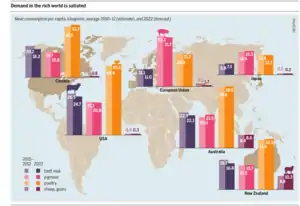

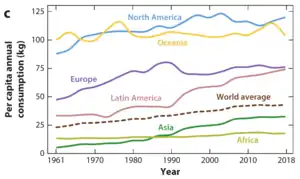
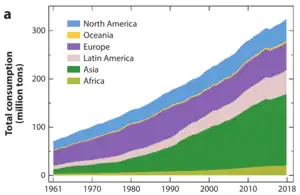
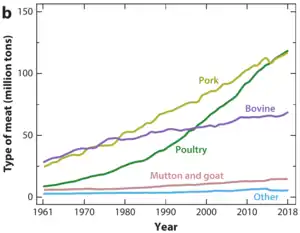
.jpg.webp)
